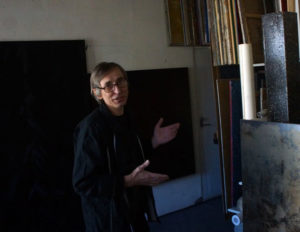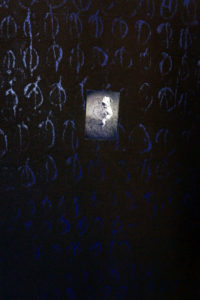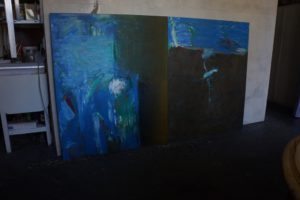Information about SPAR
Mariëlle van den Bergh / SPAR 15-07-2017
If you are considering to apply at SPAR, please read this interview Marielle did with SPAR director Anastasia Patsey:
Mlle: What is SPAR?
A: SPAR is Saint-Petersburg Art Residency. It is a programme that is located here, at the Art Centre Pushkinskaya-10. It started in 2012 and basically it functions as any residency programme. Visual and performance artists, as well as researchers, curators, writers, and educators come to Pushkinskaya-10 to live and work here on their projects. The period of stay depends … read more
Artists at SPAR in May and June 2017
We met Suus Agnes from the Netherlands, Marina Ross from USA, Andrea Stanislav and Dean Lozow from USA. Suus stayed 3 months, Marina 2 weeks, Andrea and Dean a couple of months and were actually at SPAR for the fifth time (with their dog). Mels and I stayed 2 months.
Marina Ross‘ project was Care for Beauty. She is an emerging artist from the USA, who is now enrolled in the MFA program at the University of Iowa. Her painting practice currently deals with the (self)image of the female body in the era of social media. The residency at SPAR is part of a larger research and is focused on studying representations of the body through visiting local museums, conducting interviews and creating new works. The works of the series “Care for Beauty” deal with the representation of rituals related to beauty such as applying makeup, looking at oneself in the mirror, as well as such events in a woman’s life as pregnancy and marriage, that often transform the strategies of (self)representation. The artists finds inspiration in the stories told by the female users in social media, staged photo-sessions, editing and careful curation of the visual content, short captions and comments and scenes from the well-known American TV series “Girls”. (Text SPAR)
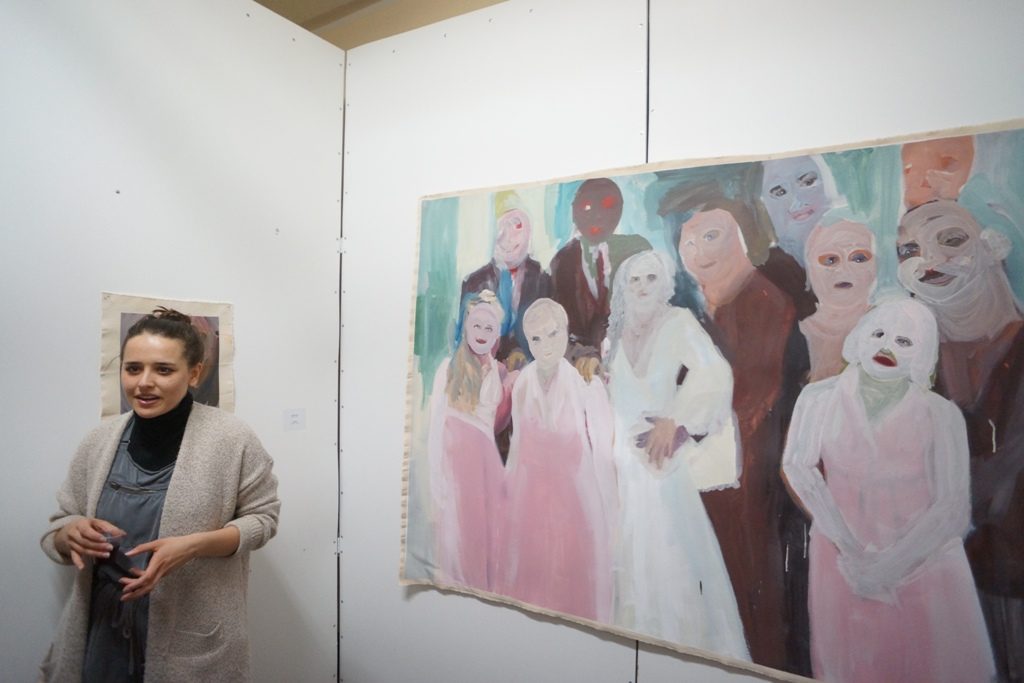
Marina Ross
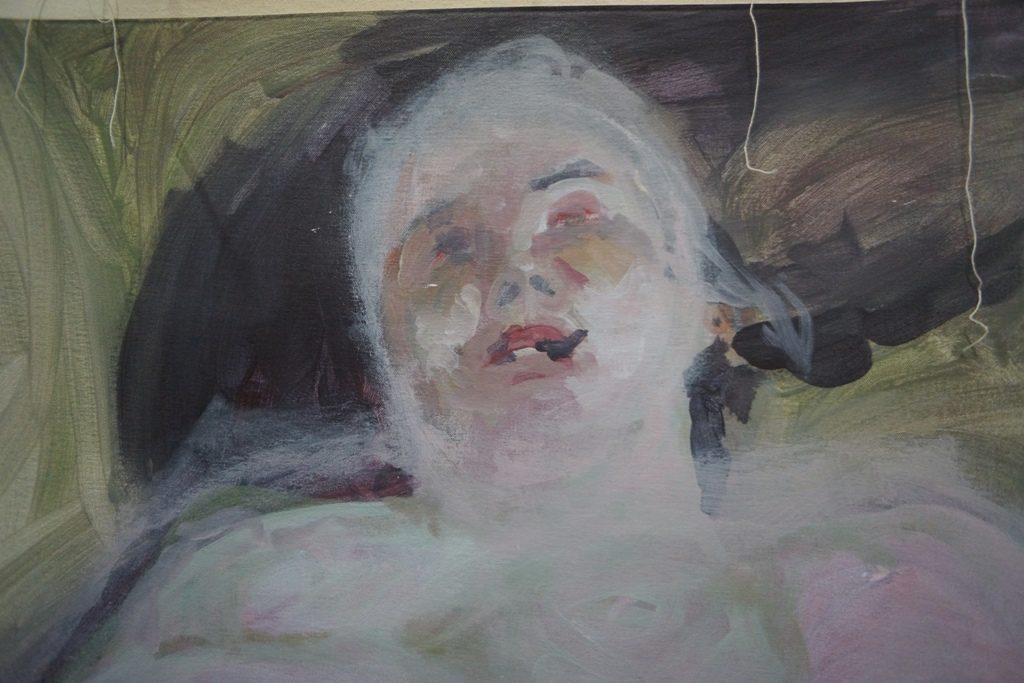
Suus Agnes’s project is called: Connect: Ecological Comics. Is a human being part of an ecosystem? Are humans simply animals? Do we have an obligation to look after the natural world? There are many ways to answer questions like these. Here in Russia I have spoken to people in remote and rural areas about their connection to the natural environment. I travelled to their houses, communicated digitally, or met them in the city and received a wide range of perspectives: from the problems with forest fires and bee populations, to the joys of living close to nature. A fire-fighter tells me it’s impossible for het to live a city life when she knows large parts of Russia are on fire every year. An Arctic scientist tells me about the methane gas bubbles that are appearing in the Far North due to melting permafrost. He calls for more awareness for the changes around us, so that we can adapt better in the future. A beekeeper explains how humans can both help and damage bees; and a villager speaks about the disconnect between people in cities and in the countryside. Each unique voice is visualised by choosing different artistic materials and colours. This is the beginning of my mixed-media graphic novel, in which I collect stories about the many ways humans are connected to nature. Suus Agnes is a comic artist from the Netherlands. Her work explores the meeting points of narratives, visual arts and environmental education. She completed a Master’s in Creative Non-Fiction Writing (Science Communication) at the University of Otago in New Zealand, and is trained in organic gardening, beekeeping, and nature conservation. Her narratives often investigate the connections between people and the natural world. Her work has been exhibited at galleries, libraries, stores and festivals in New Zealand, Australia, and Canada. (Text SPAR)
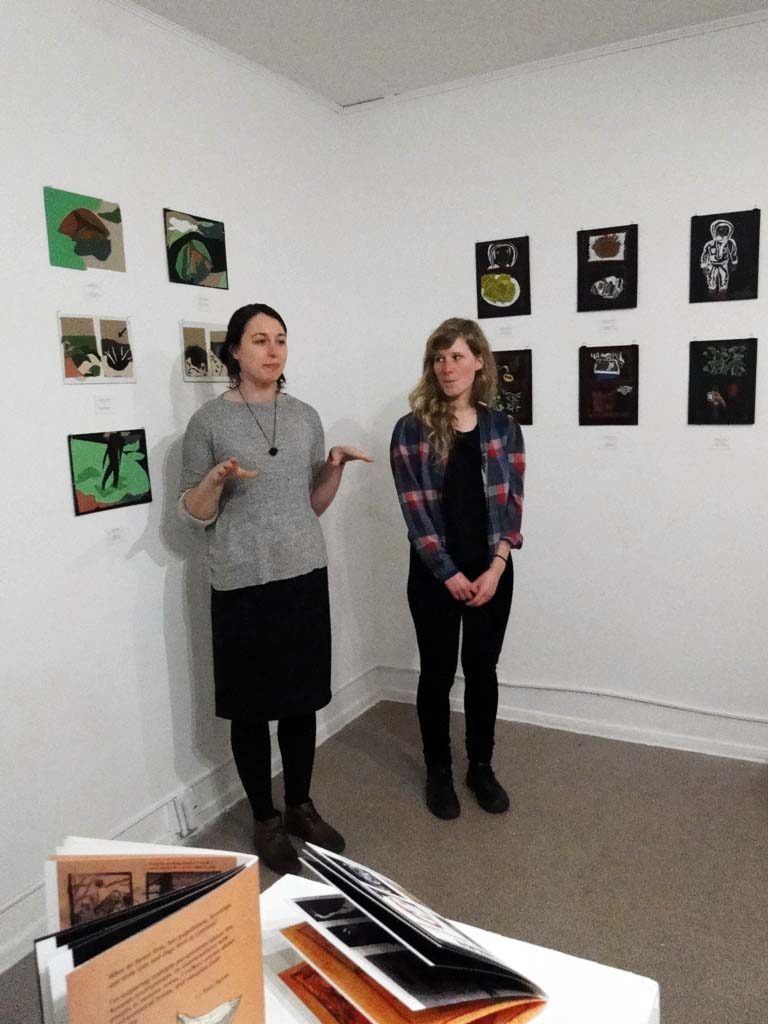
Anastasia en Suus tijdens opening
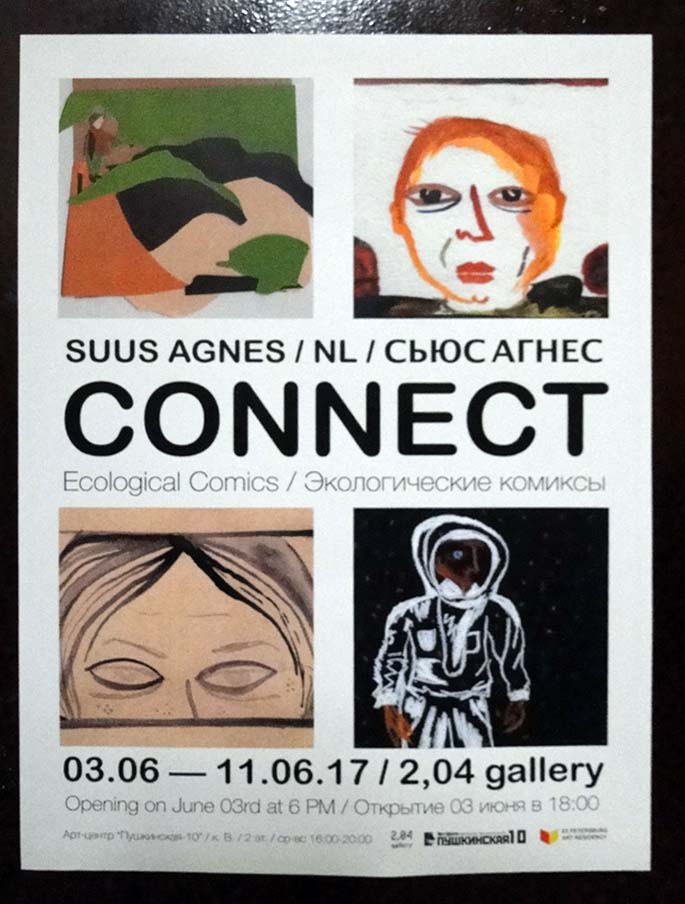
Werk Suus
From the SPAR website: American artists Andréa Stanislav and Dean Lozow deserve the status of our ‘annual artists-in-residence’. They came to SPAR for the first time in 2014 and have been developing their work in St. Petersburg and Russia ever since. The multidisciplinary practice of Andréa Stanisalv engages sculpture, installation, video, and public art. She received a MFA from Alfred University, New York; and a BFA from The School of the Art Institute of Chicago. The works of Andréa Stanisalv have been exhibited internationally at museums, contemporary art centers, galleries, biennials, and art fairs and are part of institutional and private collections worldwide. She is an associate Professor of Sculpture in the Department of Art, University of Minnesota – Minneapolis and the recipient of numerous awards including, including the Freund Teaching Fellowship, Minnesota State Arts Board Grant, McKnight Artists Fellowship for Visual Arts and many others. Since 2003 she works in close collaboration with artist and art producer Dean Lozow.
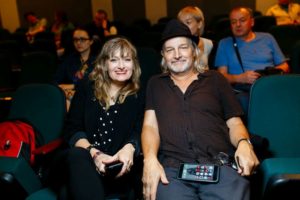
Andrea and Dean
Below are some of the activities we were introduced to by SPAR, needless to mention that we had to turn down many possibilities to be at opening of exhibitions and festivals. Just a random selection:
- we went to a concert and exhibition by the Lithuanian composer/painter/photographer/poet Ciurlionis. The event was organised by the consul of Lithuania in the Hermitage.
- Shortly afterwards, there also was a celebration and a concert organised by the Dutch Institute in Saint-Petersburg. Anastasia Patsey introduced us to director Olga Ovechkina, who had invited many Dutch and Russian scientists, business men and people from cultural or otherwise backgrounds.
- At the courtyard of Pushkinskaya-10 a famous Berlin-based performance group, with mostly Russian artists, did a spectacular show with fireworks, dancing apples, a naked horn blower, dumping an accordion in a drain hole, orange smoke and a black flag waving while paper snowflakes fell down on the public.

- Anastasia also organised a trip to a former Soviet building, parts of which possibly will be converted to SPAR residency studios. The relics from Soviet times – murals with heroic factory workers, red mosaics, bronze statues of model workers, abandoned trash in creepy cellars and a coat rack with genuine fur hats made the trip a real treasure hunting adventure.
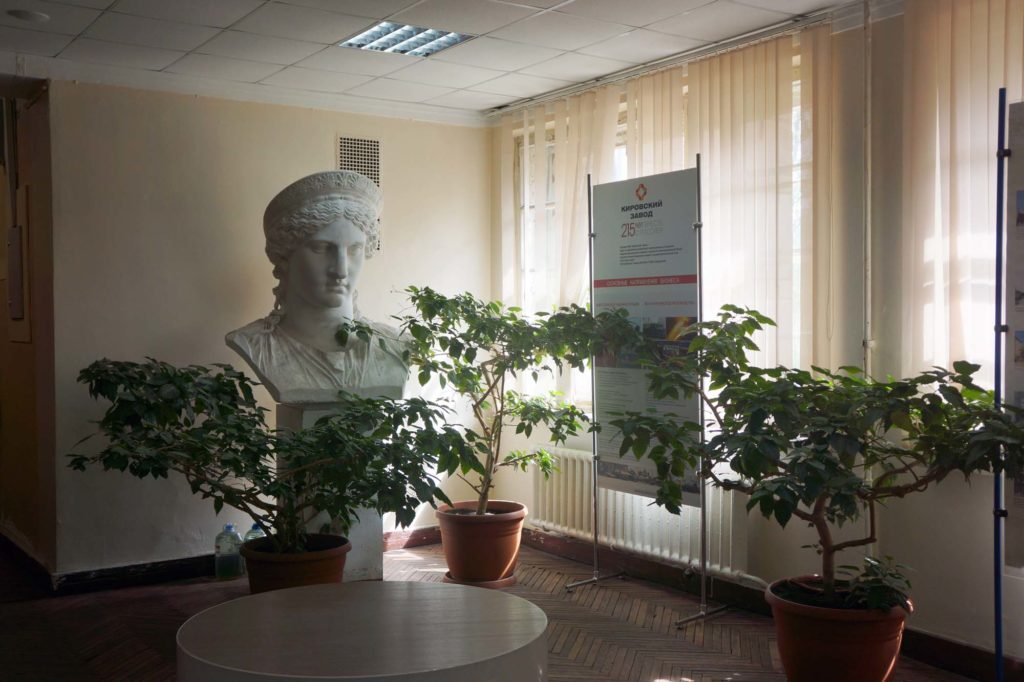
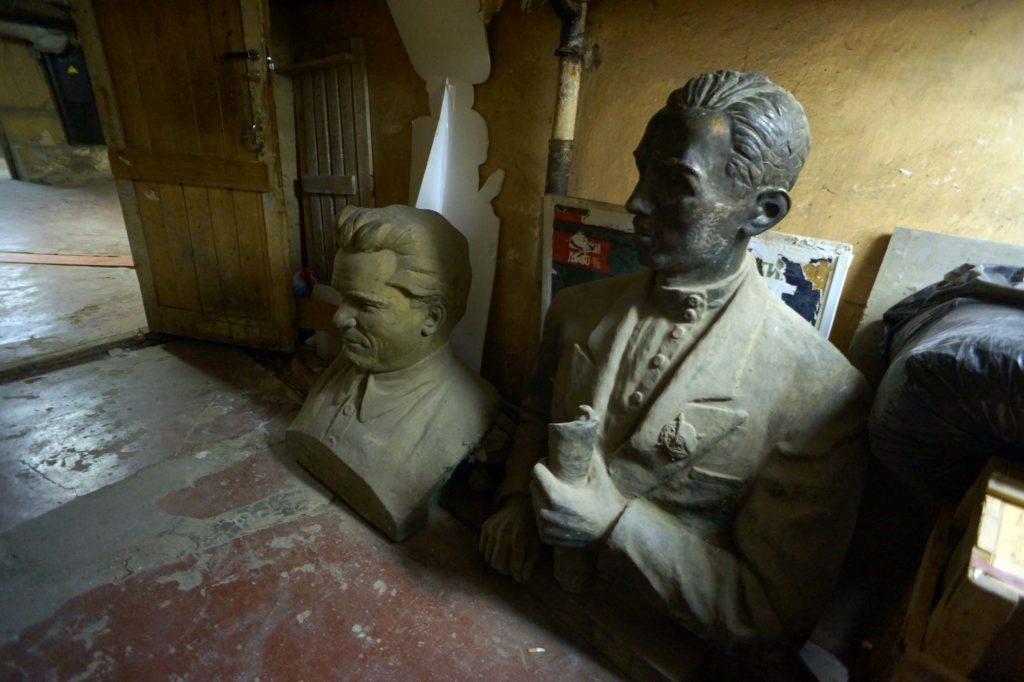

This sunspot is mine: two exhibitions in St. Petersburg
Mels Dees, 25-06-2017
For an artist, the experience of visiting an exhibition will often differ slightly from most other people’s. Seeing someone else’s work may feel as if you enter his/her bedroom. Or his skull. Or, indeed, his studio. If there is any kind of rapport, you, as an artist, will be able to see what the exhibiting artist is trying to accomplish. And sometimes you are able to judge if his or her effort is successful – and that may make you happy, just happy. Or it can make you feel superior (such a lazy solution!), angry or envious.
But to me, the very best exhibitions I saw as an artist always made me think: I want to get out of here. I have to go to my studio straight away and get to work. Because, yes! This is what art is about and I cannot waste another minute to make it clear – in my way. And you dig in, you work and work, until you even forget who or what it was that got you so excited.
However, in St. Petersburg I found out that there are more ways in which other people’s art can support an artist: it may, for instance, make you feel at home. In this city I realized once again that making art is a way of living. Not just a career, not a way to create wealth or fame. It can, and maybe should be first of all, a way to create fragments of meaning, tiny chips of our dark and immeasurable reality that become intimate household objects. This sunspot is mine.
During the past month or so, two exhibitions in St. Petersburg have given me that almost forgotten feeling, the feeling that it’s all right. That it’s all right that all of us are working our ass off to create something worthwhile, while very few people understand or even care. And even that it is all right if you are barking up the wrong tree, selling nothing or getting no audience as long as you or someone else derive a moment of understanding from it – and probably even if nobody ever does.
ART MECHANICA at Kuryokhin Center
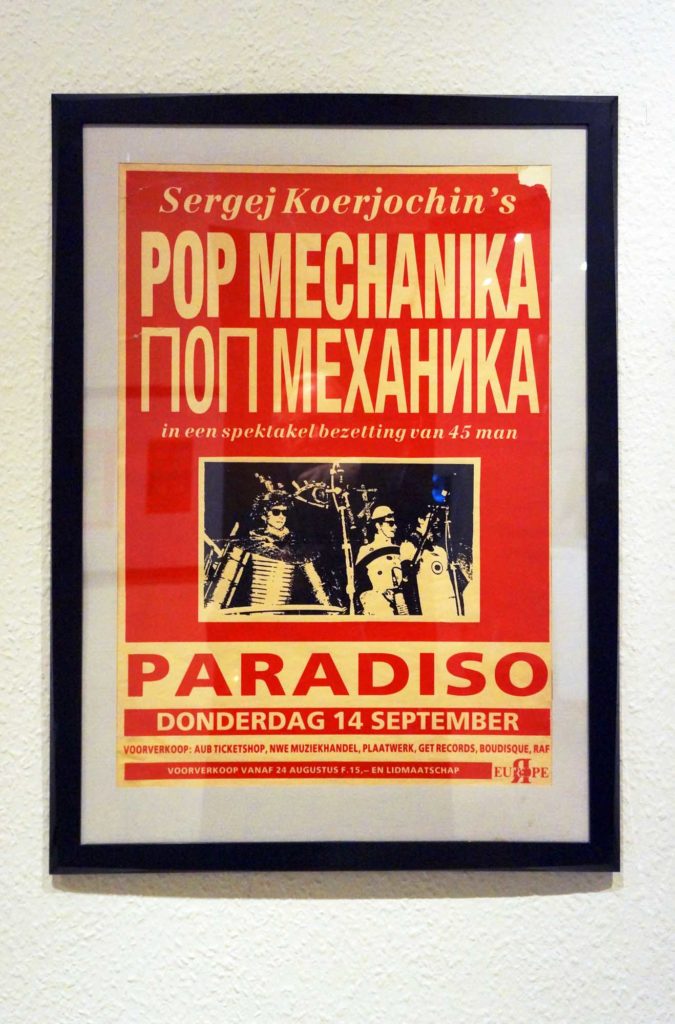
In the nineties, performance artist Sergey Kuryokhin travelled around Europe with his Pop Mekhanika show – and of course visited Amsterdam as well.

His shows were seemingly chaotic but mostly well-choreographed, featuring for instance a military band, choirs and a host of pop and jazz musicians
The first exhibition, Art Mechanica at Kuryokhin Center, often evoked the time that St. Petersburg still was Leningrad and art was a game you played against the establishment, authorities and stuffy teachers. In the ’80s and ’90s, Kuryokhin was a famous composer, pianist, experimental artist, film actor and writer from St. Petersburg. Several recordings of his wild and exhilarating performances were to be seen (to get an idea, see Sergey Kuryokhin live in Helsinki 1995, on YouTube), and the other artists reflected their mood, although in a less violent and restless way.
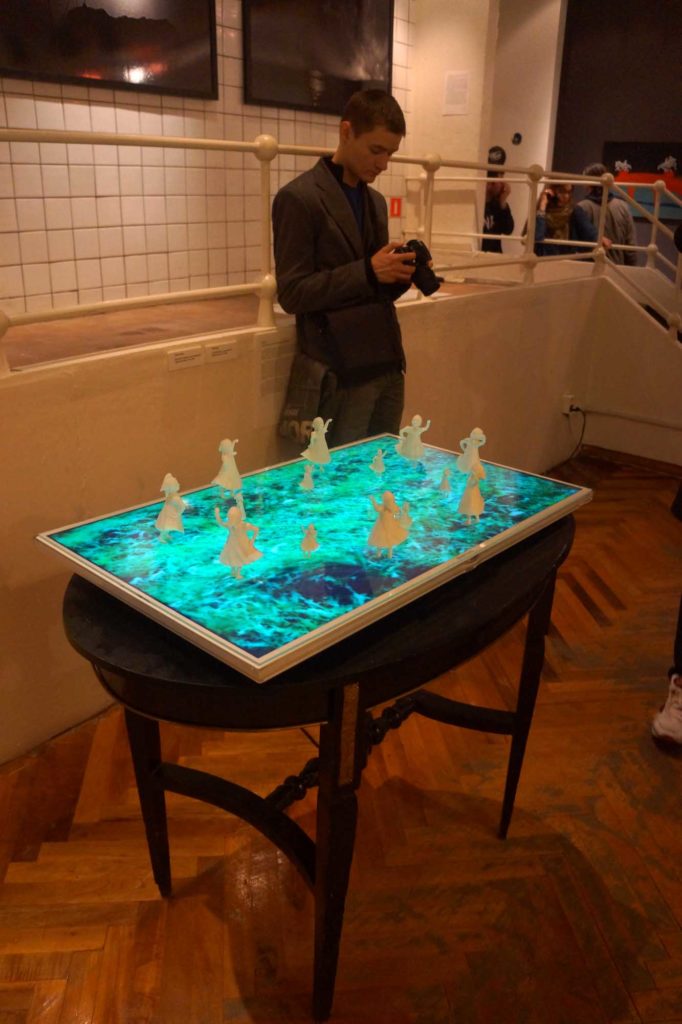
Ludmila Belova created the installation Overture, with 3D-printed porcelain figurines and music by the 17th century composer Jean-Baptiste Lully. This short movie fragment gives an impression (although the music is mostly drowned out by other sound installations).
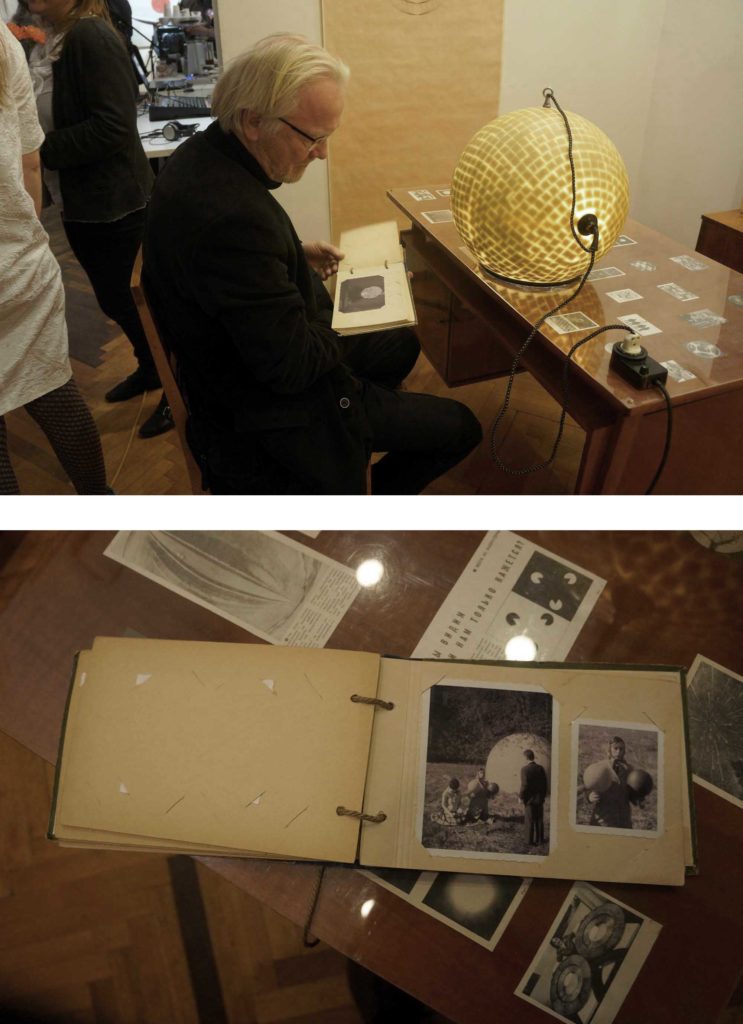
The spherites is a complex installation by Daria Pravda, representing the ceremonial room of a fictional sect, the Spherites, which is supposed to have developed in Kronstadt, an island fortress close to St. Petersburg

Visitors can partake of the ceremonies of the sect, dating from the 60s, with typical soviet-era paraphernalia and a mystical spheroscope

.

For his sound sculptures Sergey Filatov uses high-tech materials and advanced technology to obtain subtle, sometimes barely audible effects (see and hear this fragment). He also is an author and musician, and he develops musical instruments.

‘rejected’ in the museum for non-conformist art
The second exhibition is in the Pushkinkaya-10 museum in St. Petersburg. Its title, Rejected, suggests connections with the ‘Salon des Refusés’ in 19th-century Paris, or with the Russian underground abstract art in the 1970s. But the exhibition shows that art can be rejected in many ways. There is a painting that was created because a piece of canvas was spread on the floor to catch the paint dripping from the piece Ivan Olasyuk was working on. ‘It received everything the other painting rejected’ – Olasyuk framed it years afterwards.

Of course, there were a lot of works that had been rejected in a more literal sense: Nikolay Yakimchuk’s collage of Putin, Rasputin and Putiatin (a 19th-century Russian Admiral) has been refused several times ‘because of the risk it would be damaged’. And ‘Alcoholorous’ by Mikhail Melnikov-Serebryakov was not accepted in the ’80s, because the exhibition committee said: “We all love drinking, and you’re criticizing such an amazing habit!”
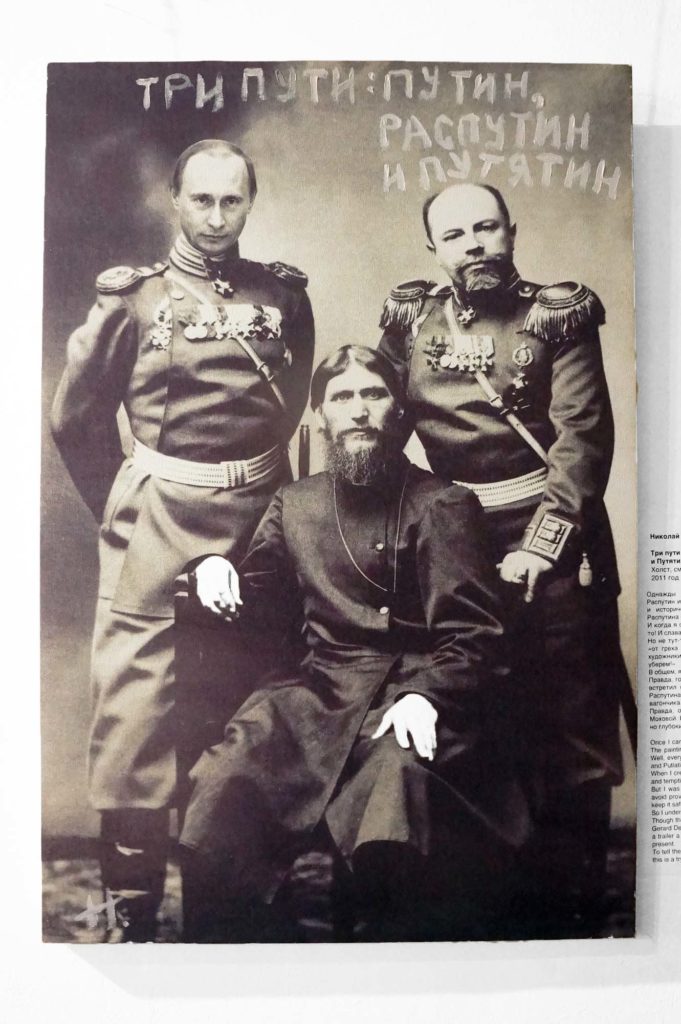
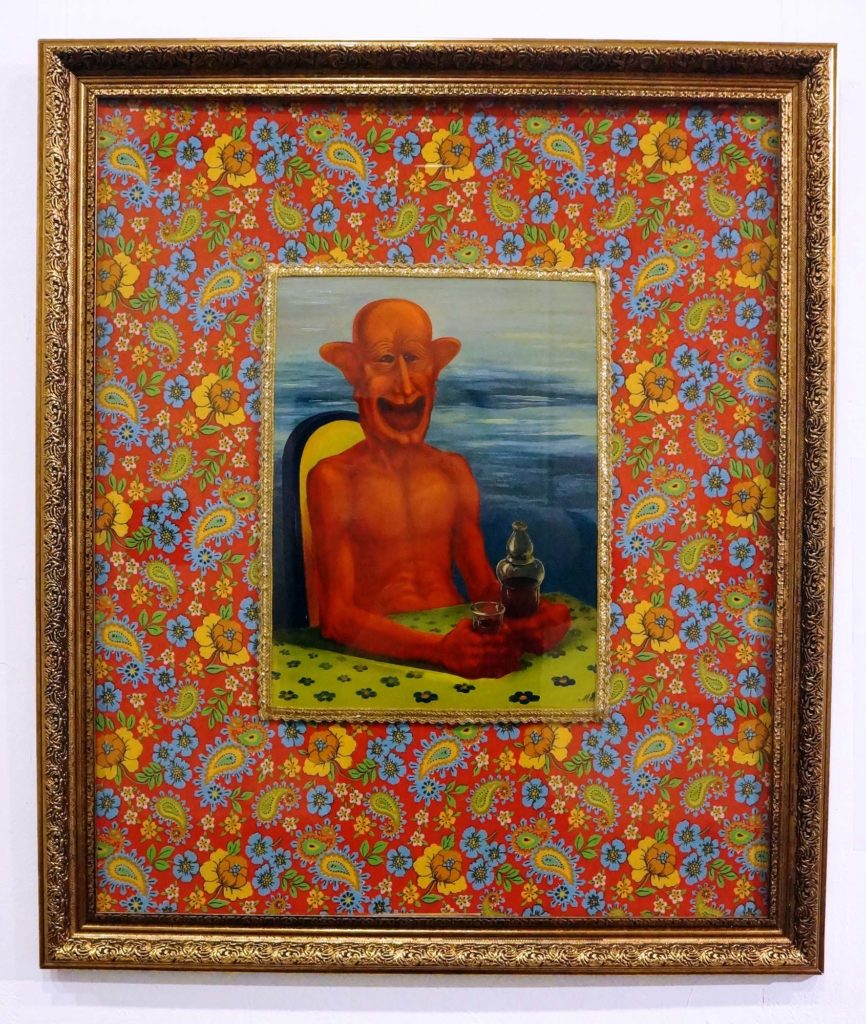
There were other obvious reasons why painting had been rejected or somehow ‘got lost’:
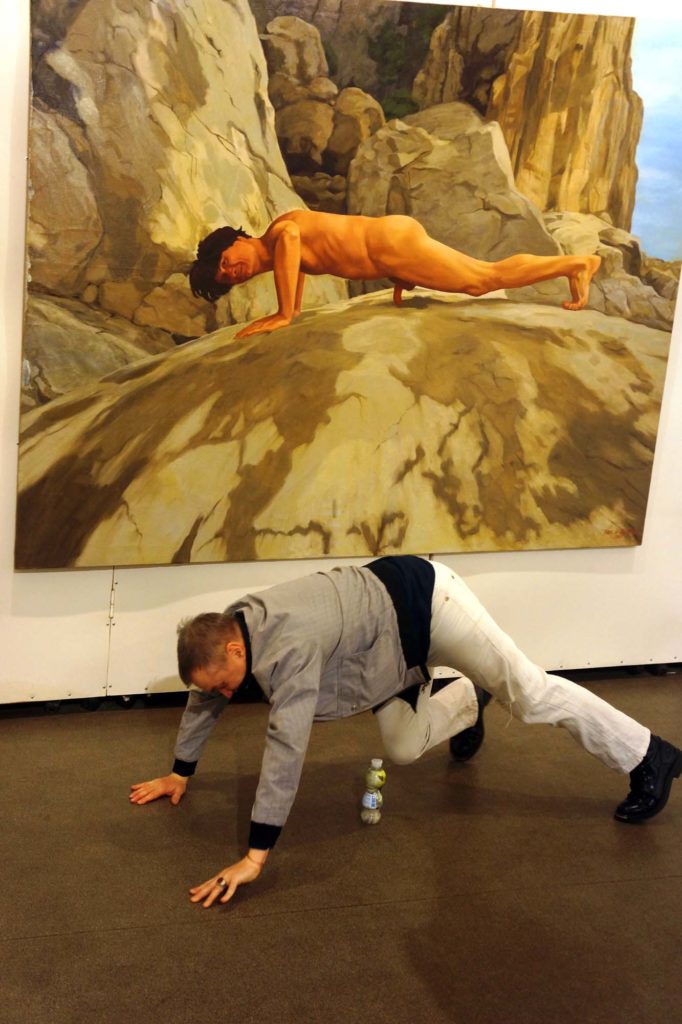
The model depicted is a rather well-known Russian art critic, while the artist shows how he constructed the image
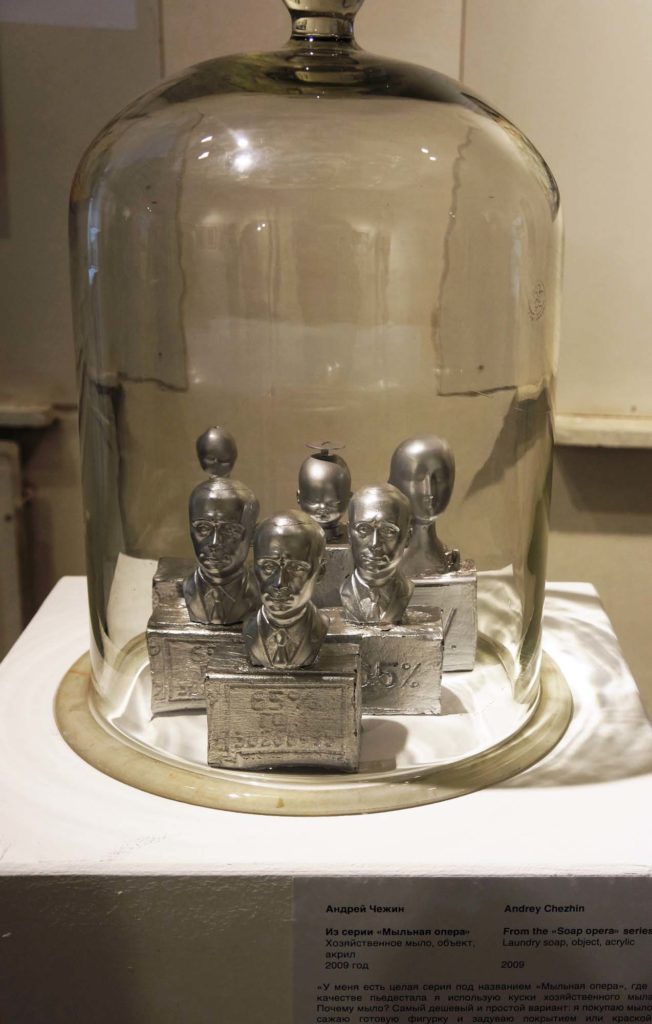
Andrey Chezhin’s Soap Opera had not been shown before
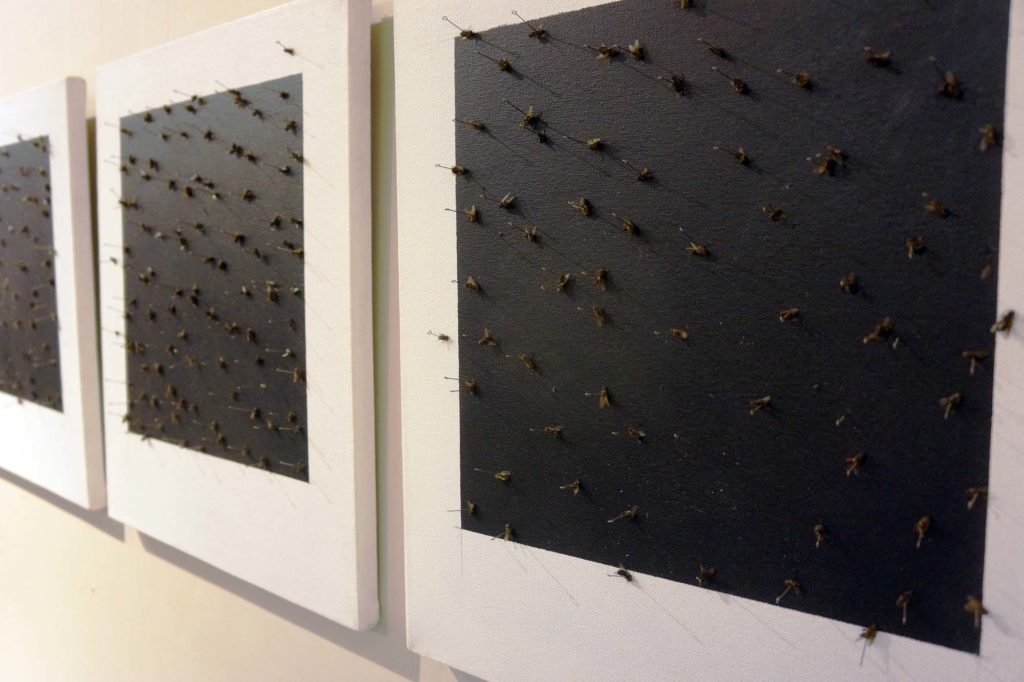
Even here the fly-ridden paraphrases of Malevich’s sacrosanct Black Square by Alexander Goncharuk were so controversial that the wall tekst was ripped off
The ‘Rejected’ exhibition was a pleasant surprise, which was not in the first place due to the superior quality of the works (although there was some pretty nice stuff), but because it contained a laid-back and humorous comment on St. Petersburg’s history of censureship and struggle for artistic freedom. Things obviously have not been easy for the artists here, but most seem to cope with a kind of carefree impudence. On top of that, the collection stressed the fact that a lot of the rejecting was done by the artists themselves, on the basis of their own criteria and judgments. And finally, the show as a whole implied a sly poke in the eye of the curators themselves, who are the new ‘powers that be’, the judges on which the artists’ success or failure depends in these neocapitalist days.
PUSKINKAYA ARTISTS
Mariëlle van den Bergh and Mels Dees, 14-06-2017
By now, we have got to know some of the inhabitants of our building, Art Centre Pushkinskaya-10. Let’s start with young Sasha, a sound engineer who helped us with our presentation at the Museum Night, together with his colleague Dimitri. When we returned the beamer to his studio we found him with the cat Marushka. Marushka is a temporary ‘lease’ guest at Pushkinskaya. She has only one eye, a feature dating back to the days of her life as a street cat. She doesn’t know how to purr, but she and Sasha sometimes collaborate in making works of art. She stretches out on the warmest place in the room: the copy-machine, and Sasha presses the button. Sasha also works in the sound studio on the second floor and in his spare time he composes electronic music. Some time ago he played with the idea to go abroad and study electronic music, but decided he was fine where he is right now, doing exactly what he likes. He also collects rare music on a special site on the internet, but he is only interested in rave music from 1980 to 1999. He has a hundreds of followers who attend his concerts, when he acts as a DJ. For people interested in a special, rather nervous variety of electronic music check this out, or if you want to hear Sasha’s own music:http://vk.com/oldrave
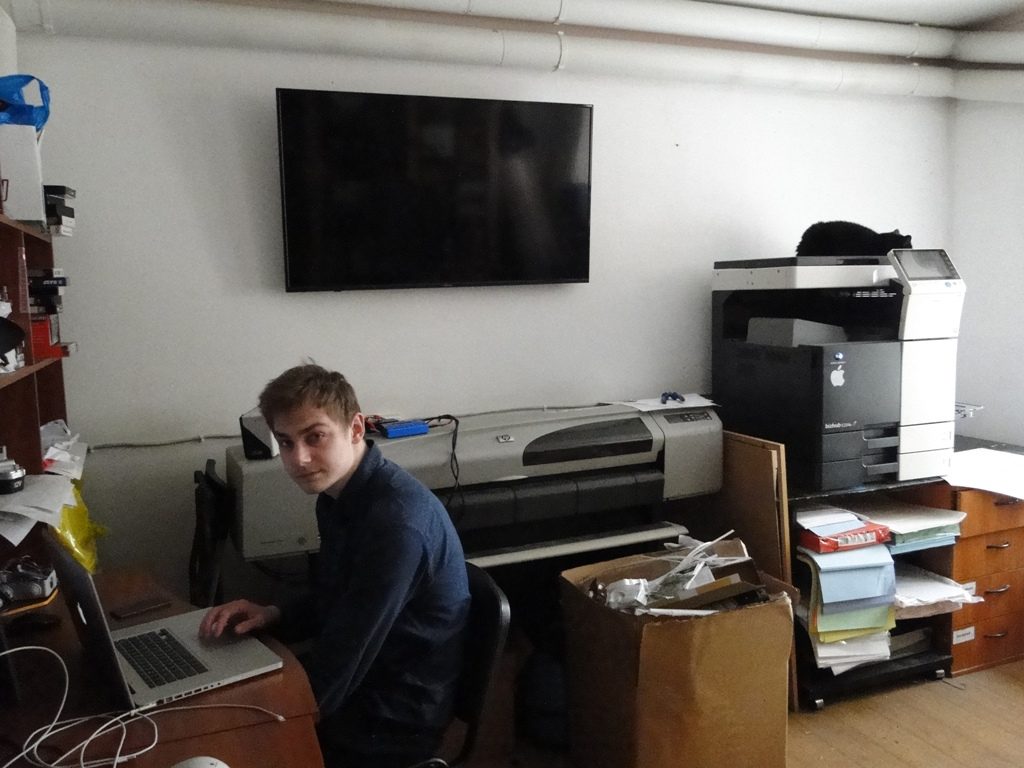
Sasha and Marushka
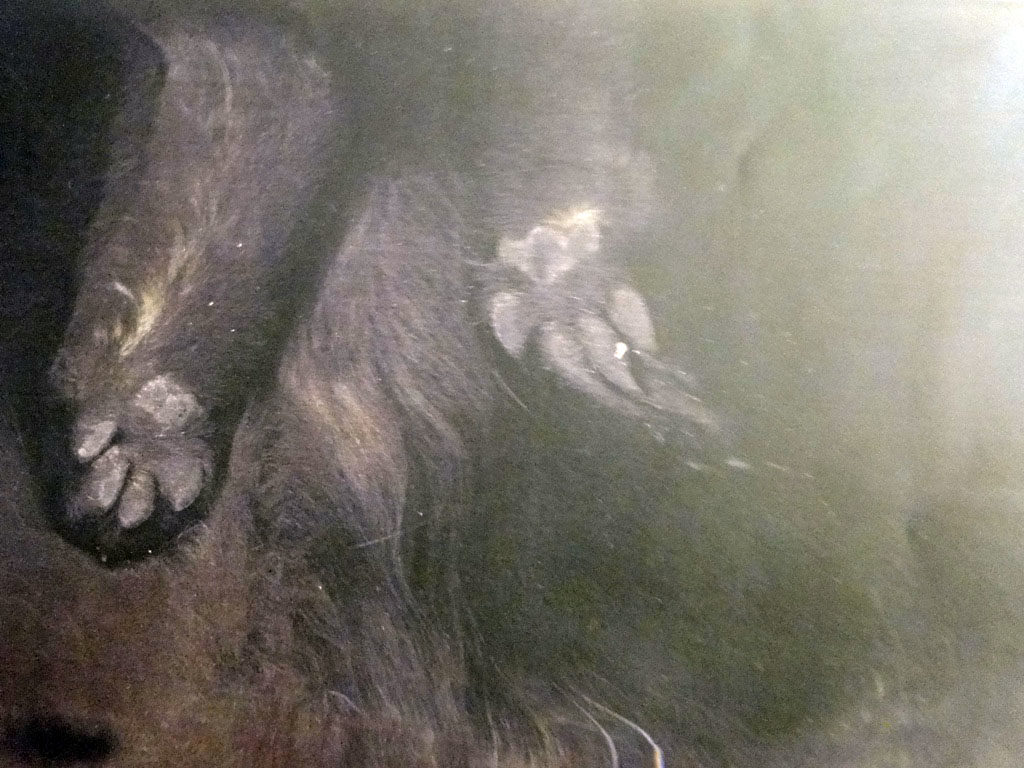
Cat art
The next artist we came to know is Mikhail Kokorin, the maintenance man. After installing our new washing machine he showed us his wood mosaics. It is a typically Russian craft and he is good at it. How high the standard is can be seen in the Hermitage, where a lot of floors are made from precious woods, composed to the most intricate patterns. Michael showed us his kingdom, hidden behind the door with a “Komadante Hulio” sign and adorned with a cannon. During the twenty years he has worked in Pushkinskaya, he accumulated an enormous collection of works by the resident artists. We see his problem: there is more art than wall space. In his homely room in the back there is a series of his intarsia icons, in various kinds of wood, carefully shaped and inlaid.
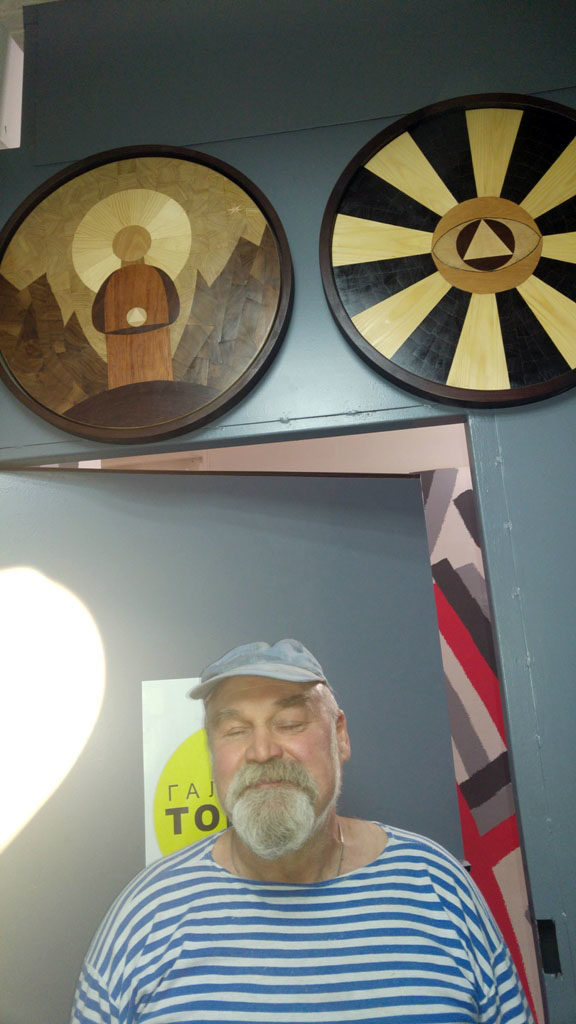
Mikhail
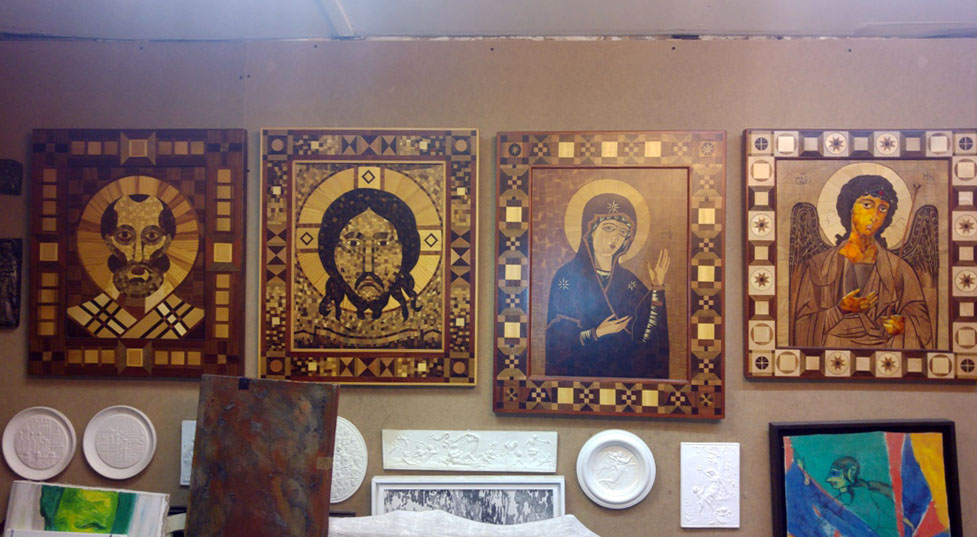
Mikhail’s intarsia icons
Yulia, curator of the exhibition in the Great Hall introduced us to painter Ivan Olasiuk. We speak German with Ivan, who worked as an artist in Germany for some years after the Soviet Union dissolved. After staying in a small village near Stuttgard, he lived in a house in Berlin that was rented by German friends and where Rolf Biermann was a frequent guest. Ivan had exhibitions in Germany and other countries and we are impressed by his paintings. He says he wants to work in a human world: “Arbeiten mit einer menschlichen Welt”. Slowly his paintings seduce you. Layer upon layer can be unravelled, as on an old painted wall. There is a lot of depth in theses seemingly simple works. Language is very important for Ivan and to him, only the Russian language can express what he intends to say. But then again: Ivan is a visual artist and his true language is visual. Ivan sometimes works on a painting for years, revising it carefully until it is right. Surface is very important and Ivan has developed unique techniques that give the canvasses a worn-down appearance or just the opposite: very velvety and shiny. He doesn’t adhere to a fixed style or school. Sometimes he also inserts objects like photo’s. The painting “Das Kind” (The Child), which has an old picture of his daughter at the centre, encircled by velvet, rather erotic symbols on a deep purple surface. The symbols are his merged initials. We were lucky to encounter a fresh black painting, which he started as an kind of action painting at Museum Night, so the public could witness its evolution.
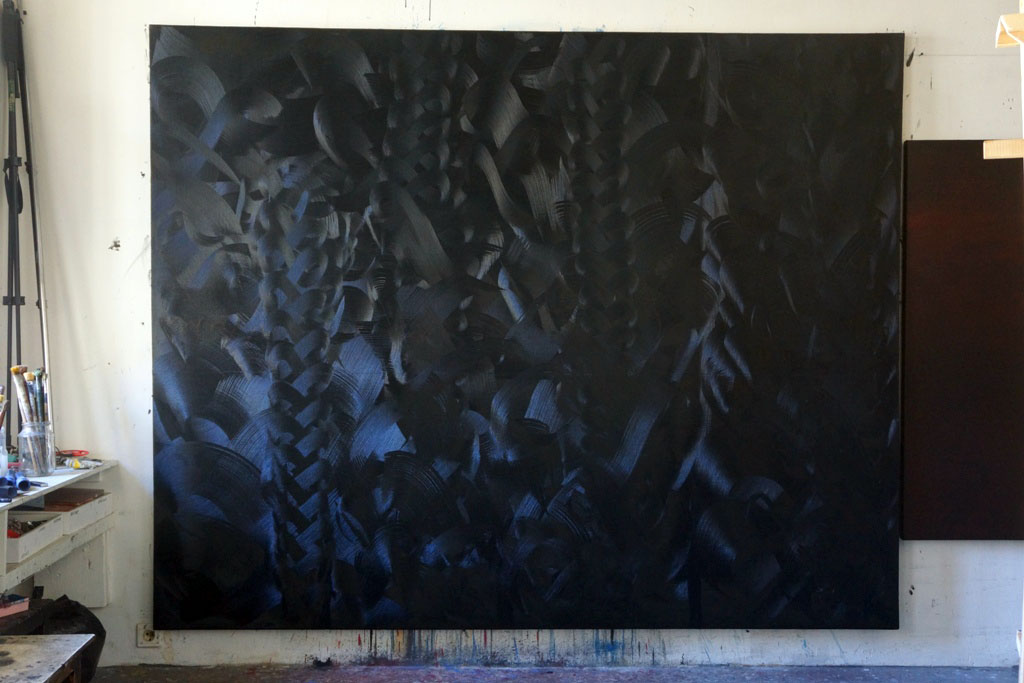
Ivan’s black painting
More about Ivan Olasiuk, see the short biography written by Yulia Pliashkevich: Ivan Olasiuk
We visited Anatoly Vasilyev in his studio, where he was preparing an exhibition in the Great Hall in Pushskinskaya in November. The title of this show will be “Wise Men” and Anatoly works with silhouettes of popes, Russian Orthodox priests but also with silhouettes of artists friends. Cutting silhouettes is a craft that was popular in the mid-18th century. Anatoly uses silhouettes and combines them with different graphic and painterly techniques to create his own universe.
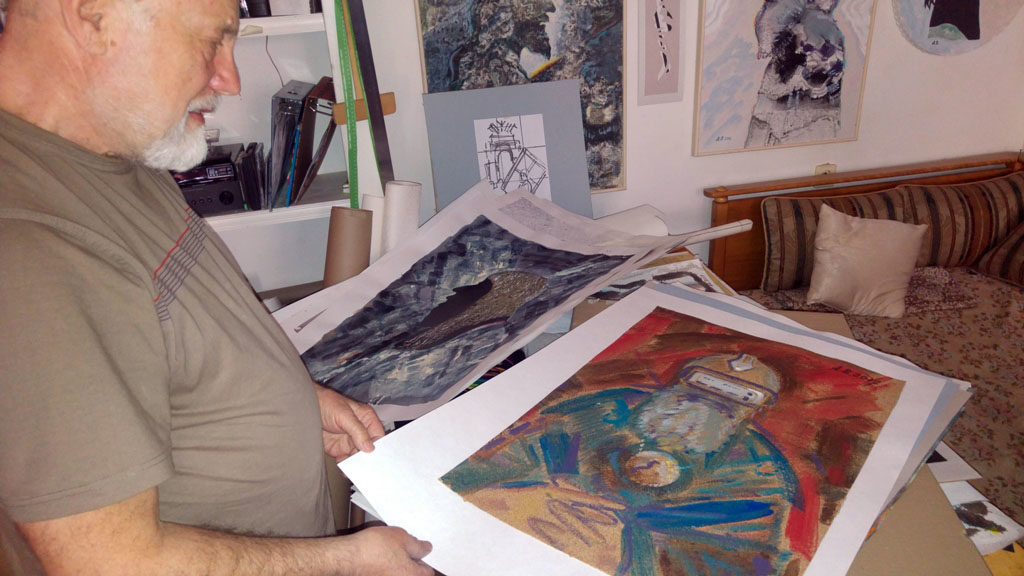
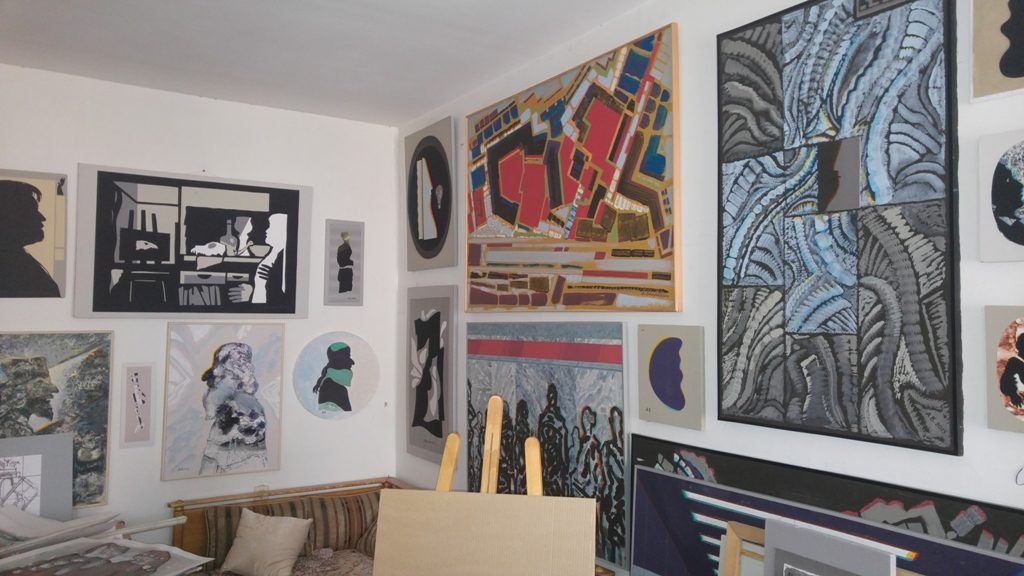
Yulia took us to a door with three apartment/studios; she herself is staying in the space of Gennady Manzhaev , who is in his home region of Siberia, but we can visit his studio. There are icons and paintings and chairs with hand-sewn textiles parts and then we see more icons, also hand-sewn. These collages are quite special: varying from a Maria with child to Soviet icons with a red star and other political or social symbols. They show great sensitivity and a sense of humour as well, and we fall totally in love with them.
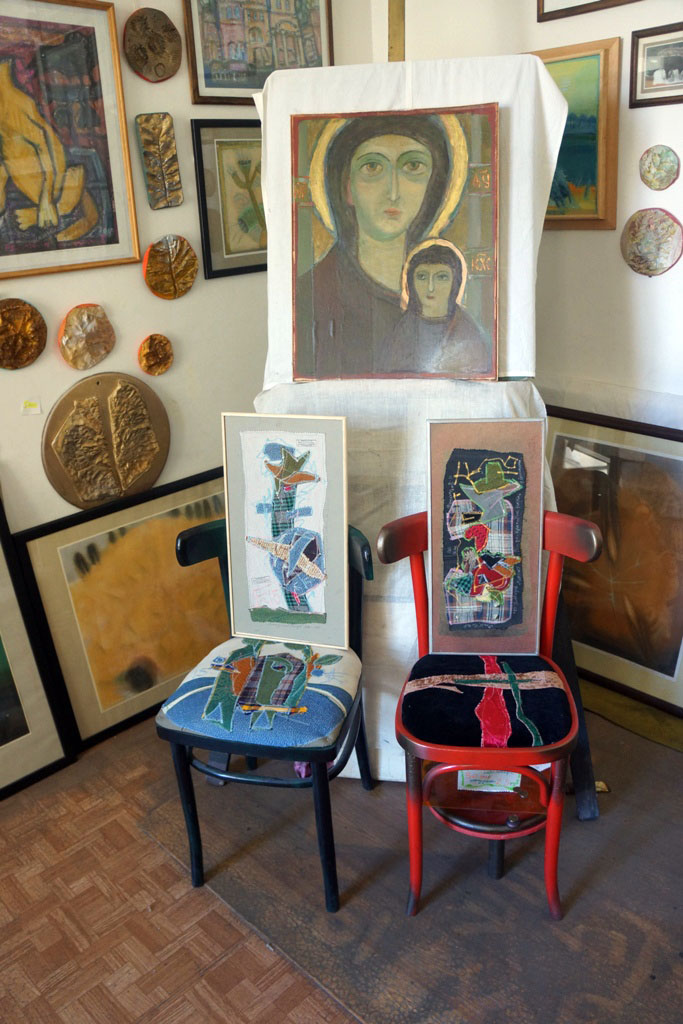
![]()
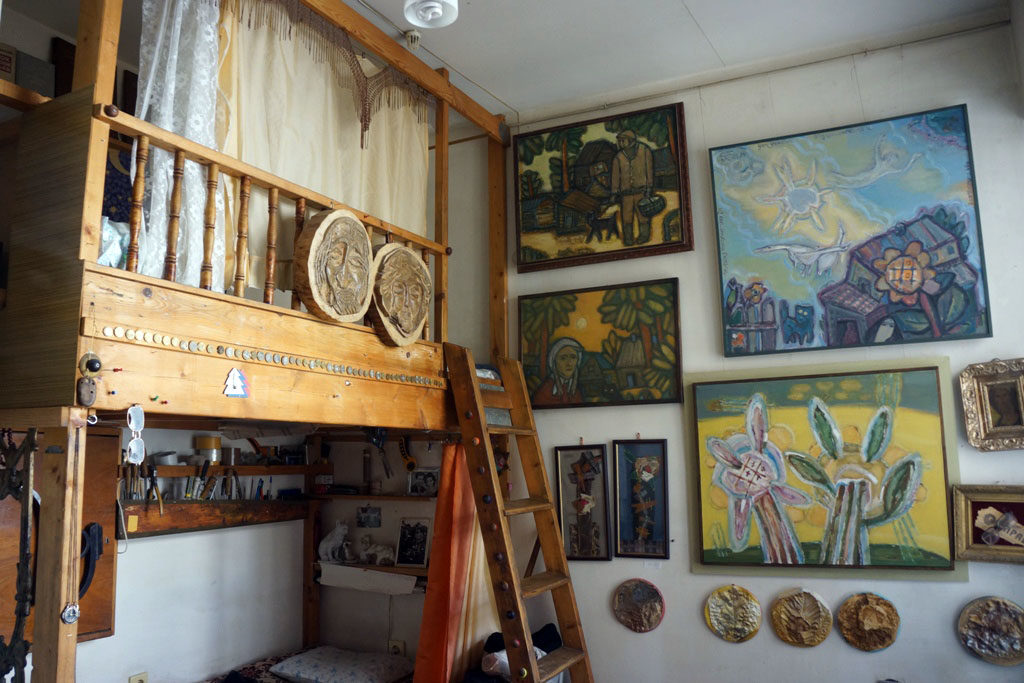
For pictures of his work go to this link and scroll down to the pictures: aslan gennadi
Nextdoor is Alexander Lotsman, a painter and draftsman pur sang. He works from nature, also plein-air, producing small oil paintings, graphic work and some pastel drawings. Alexander origins lie in the Baikal region (Siberia) and he likes visiting his old stamping grounds to fish and paint outdoors. But he also worked in France and the Crimea. If the weather is too harsh, he will build a simple plastic tent. We see gripping landscapes, beautiful evening light on small wooden houses and snow-covered villages.
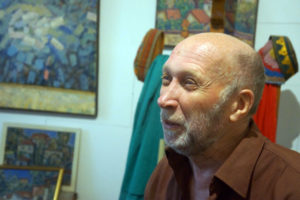
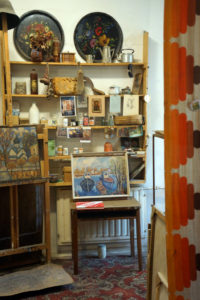
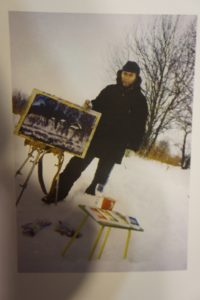
The third artist is Aslan Uyanaev, who originally trained as an architect, but became an artist instead. In Art School he had to make figurative drawings and this, as often, developed into abstract painting, which he has been doing for the last 22 years. In his studio we can see quite substantial canvasses, nearly all square. The format turns out to be based on his material: jute canvas from old sacks. The shape suits Aslan well, because he often works on the canvas while it is flat on the floor, so he can easily add elements, only deciding afterwards how it should be hung on the wall. His colours are bright and there is a light atmosphere in his work. Sometimes numbers appear, but they just seem to be a pictorial element, like the vague faces on black-and-white copy paper. Aslan is one of the few artists with his own website: www.artisi.ru and he is, like Ivan Olasiuk and Sergej Kowalski, one of the founders of Pushkinskaya-10.
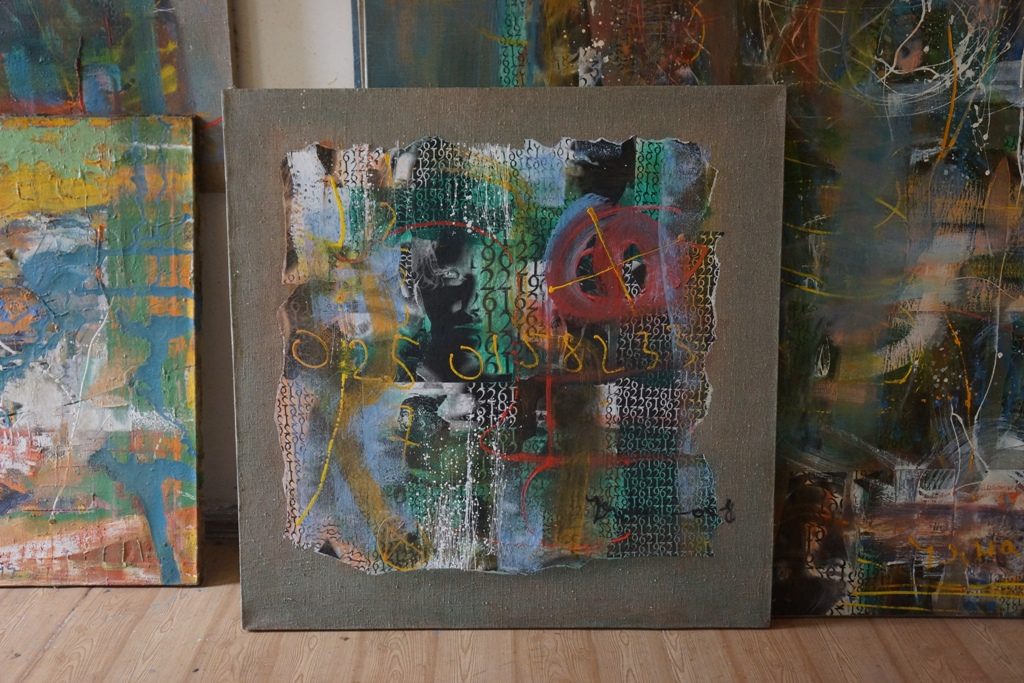
Aslan’s work
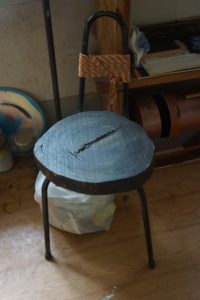
Aslan’s chair
Sergei Kovalsky,another one of the ‘founding fathers’ of Pushkinskaya-10, showed us his studio and immediately initiates us into his philosophy. We see his first painting from 1969 and we are shown the last painting, part of his ongoing project to paint memories inspired by specific music pieces as heard on a specific moment in time. We marvel at an “Alternative Icon”: green, with a hollowed-out centre: “The sacred place is empty”. We see Kovalsky’s version of the vast Parliament painting by IIya Repin in the Hermitage. Here the identical politicians are grey-faced and there are a lot of da’s (yes) in the air. In a corner of his studio we discover a display case with the leftovers of a charred, black piece of wood. Sergei claims to have dug it up from Malevich’ cemetery, during a big public performance. Of course the painting is square. It’s a comforting idea that our Stedelijk Museum in Amsterdam still has one black square left….. Another ongoing project is his Parallelosphere Philosophy. On this website, you will find a film by Monica Bernotas about Pushkinskaya-10 and Sergei Kovalsky explaining the history of the art collective and some of his art.

Sergej’s Hollow Icon
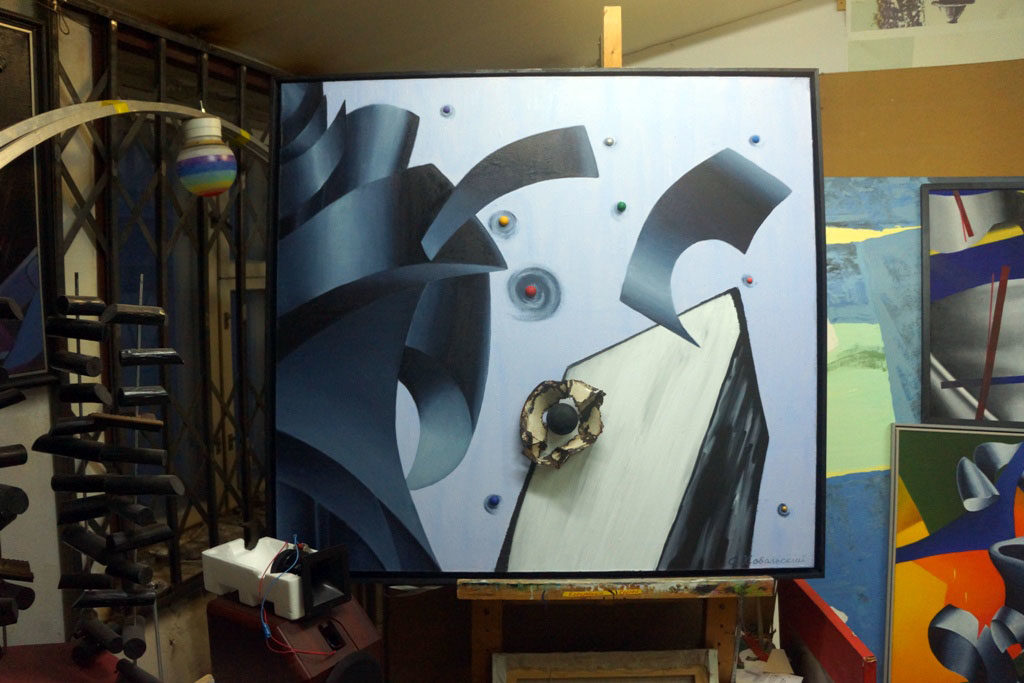
On Rachmaninov’s Music
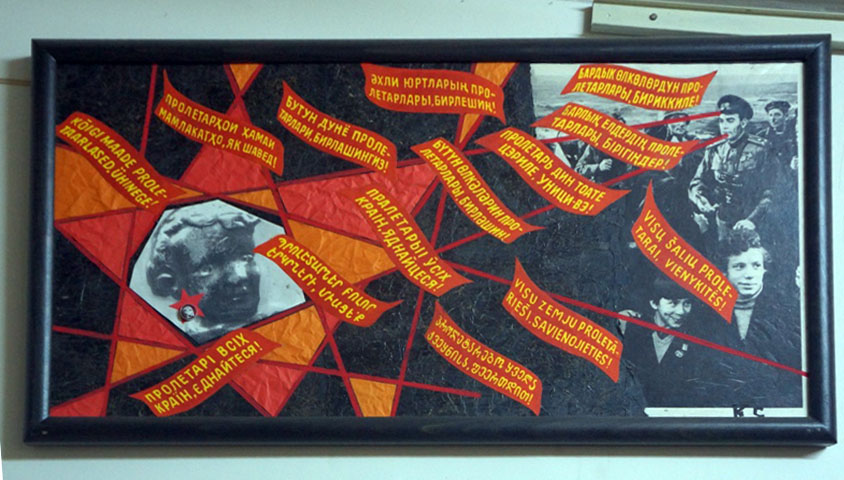
On Lenin
Read this text by Yulia Pliashkevich about Sergej Kovalsky.
Sergei Kovalsky’s website is: http://www.p-10.ru/kovalskij. If you click on pictures&music (left icon) and pictures&music&poesi-2 (right icon), you can download two great films about colours, music, paintings and poetry. See this short fragment to get an impression of Sergej’s multimedia report of the early action days at Pushkinkaya.
The building of Pushkinskaya counts 34 studios, populated by musicians, filmmakers, actors, poets, painters, sculptors and other artists. From these studios around 10 are occupied by female artists. One of them is Xenia (Eugenia Konovalova). She was born and educated in Volgograd. She had many exhibitions, some in foreign countries. In 2006 she founded the DVER gallery/Open Door Gallery at Pushkinskaya-10. In fact we have seen her at work as a curator, explaining art in the corridors to visitors of the Museum Night.
We soon discovered Xenia’s brilliant ideas and sparkling personality. There was a catalogue with pictures of the ongoing project “Carrier Cockroaches project”: big insects from Madagascar, with oldfashioned postage stamps stuck on their backs. Each stamp carries the picture of an artist. Xenia collects artist’s-stamps-on-cockroaches as she collects languages. As in the project “Close Gibraltar, Save Venice” for a future group show. Mels is able to oblige her in several foreign tongues. She will paint the translated sentences on rocks which are (nominally) from Gibraltar and should be used to build a dyke in the Mediterranean Sea to save Venice.
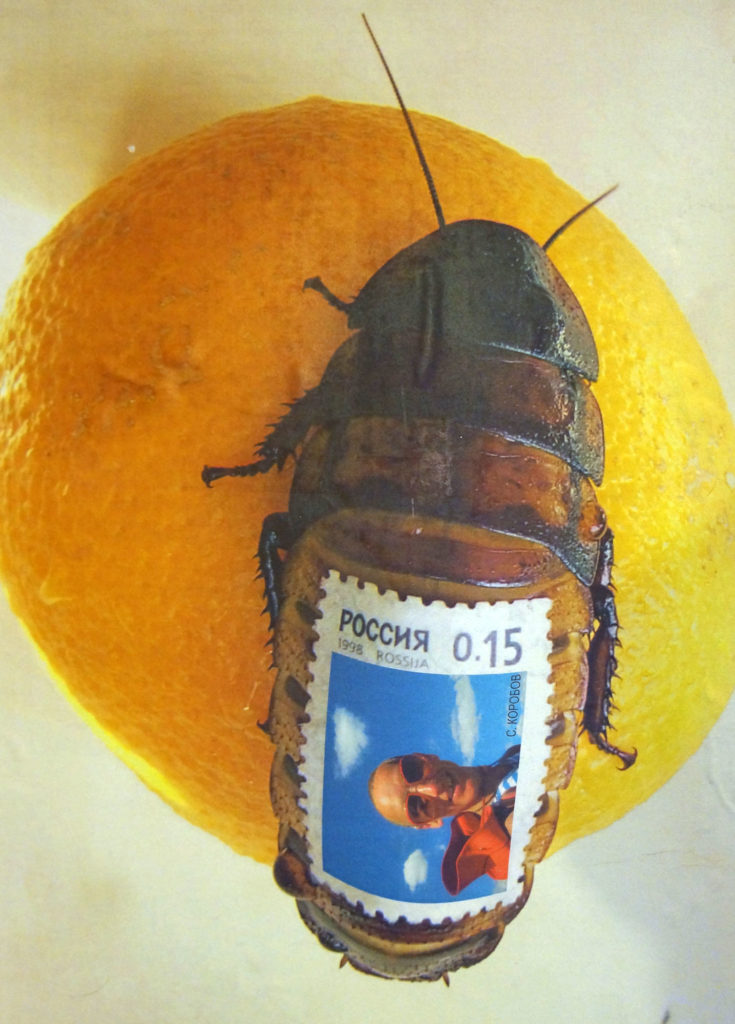
Cockroach art stamp
Another painting with dark mountains turns out to be a nostalgic painting about the spoil tips in the Donbass region, where she spent holidays in her youth. Xenia plays with language as she plays with coloured paper, cutting up and sticking pieces together, using free collage techniques. In her tiny studio we see a big painting of the sunken nuclear submarine Kursk, a round painting of the space ship Mir, another live black cat (two eyes) and a movable “Green house”, a portable Art Gallery on wheels (see YouTube movie), which she takes out on the streets with whatever art she thinks people should take notice of.
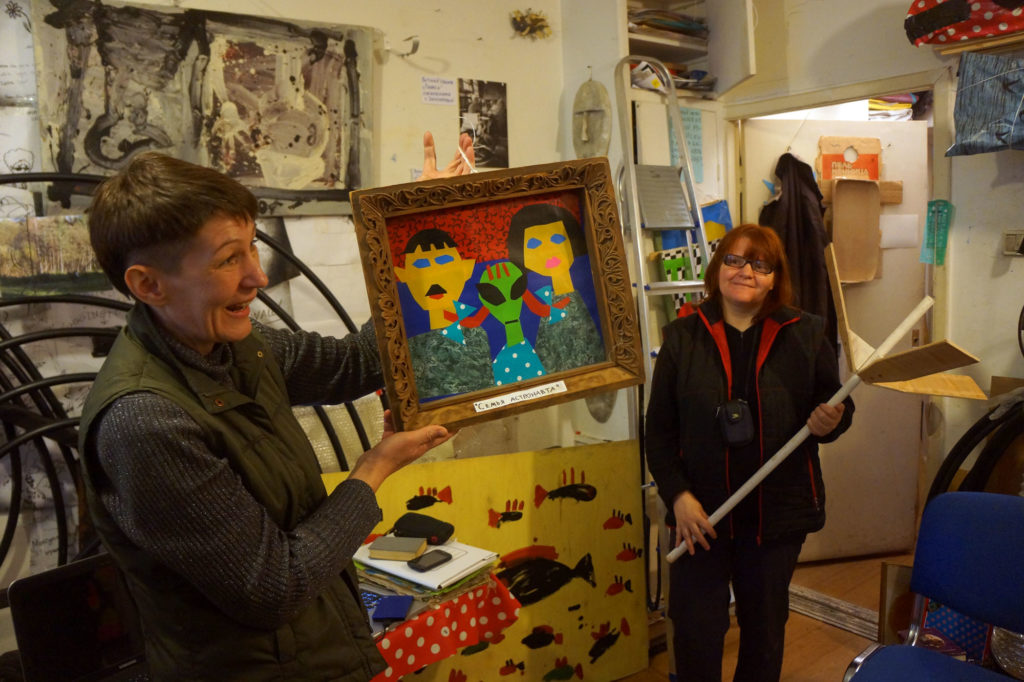
Alien with herb family on earth
Museum Night
Mariëlle van den Bergh and Mels Dees, 25-05-2017
A few days ago Museum Night hit Saint Petersburg. A huge event, lasting from 18.00 on May 20 till 6.00 in the morning of the 21th of May. St. Petersburg public transport was running all night to acommodate the thousands of visitors moving from one venue to another. As it said on the internet:
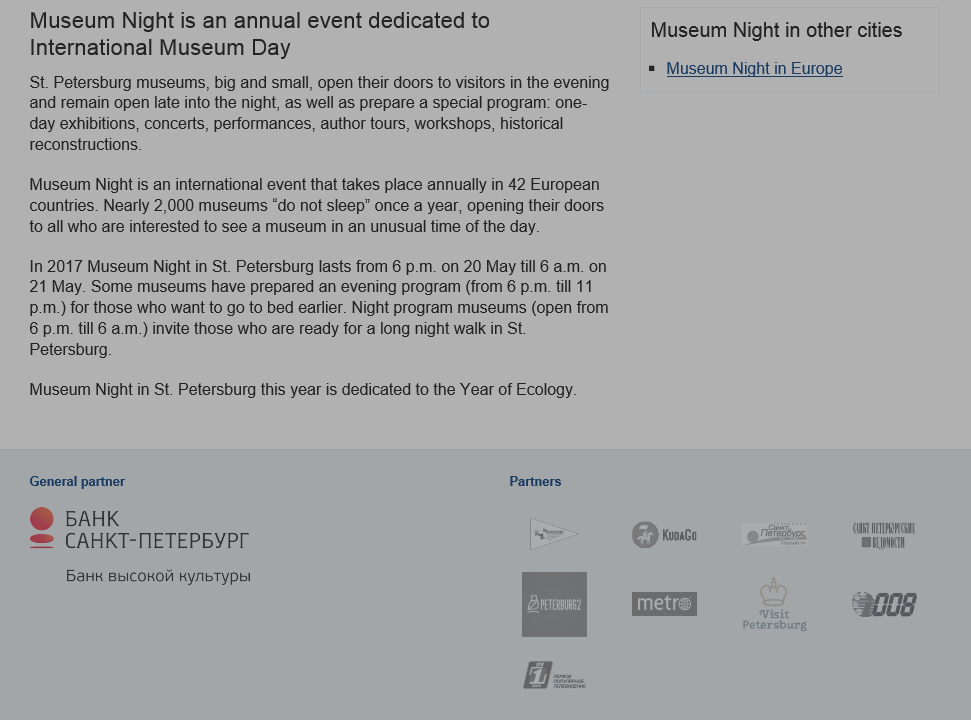
Of course the Museum Night also involved Art Center Pushkinskaya 10, the organisation which hosts SPAR, our residency programme, the Museum of Nonconformists Art, Museum of the New Academy of Fine Arts, Sound Museum, many galleries, the Fish Fabrique music club and studios of artists and musicians. Preparations had been in full swing for weeks with at least half the building being involved in the event itself.
On Saturday afternoon the show Be like Children, Saratov non-conformist art opened in the Museum of Non-Conformist art. It was curated by Yulia Pliashkevich and Sergey Kowalski. This underground group of artists literally worked from the basement of the Saratov Art Museum – Saratov is a city on the Volga river, in the south of Russia. The group’s history could be read on a poster at the exhibition.
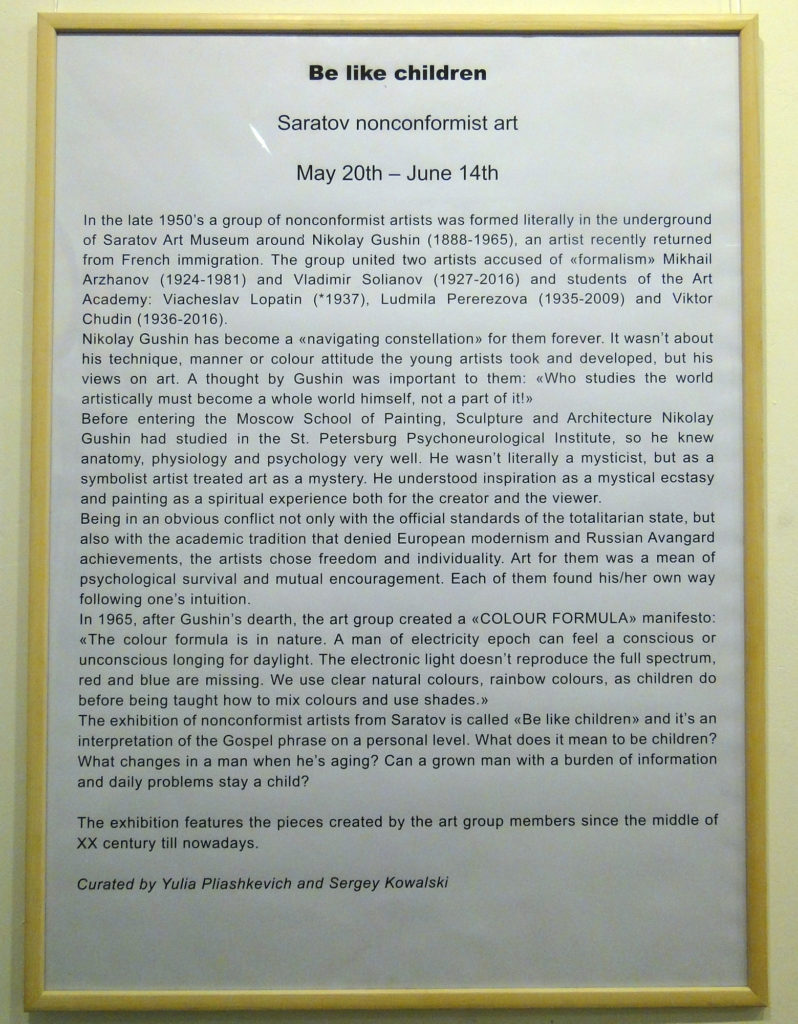
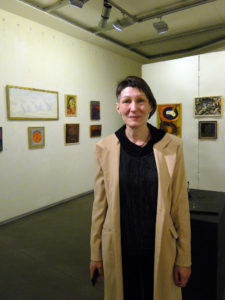
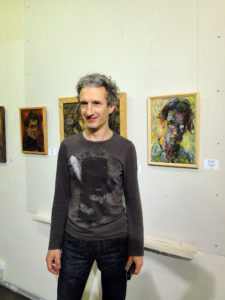
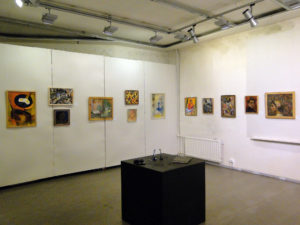
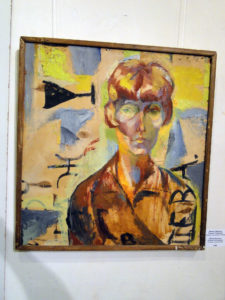
The group consisted of five artists, of whom only one member survives. The exhibition shows works by all artists, both from early times and more recent periods. There is a film featuring Vladimir Solianov, who made abstract work and shows drawings on the Volga shores of bathing people. Many of the exhibited works are executed on cardboard or wood from the museum’s transport crates. You still can see the lettering and the FRAGILE wineglass symbol. Yulia explains that very little material was available in those years. Artists had to improvise with whatever they could get.
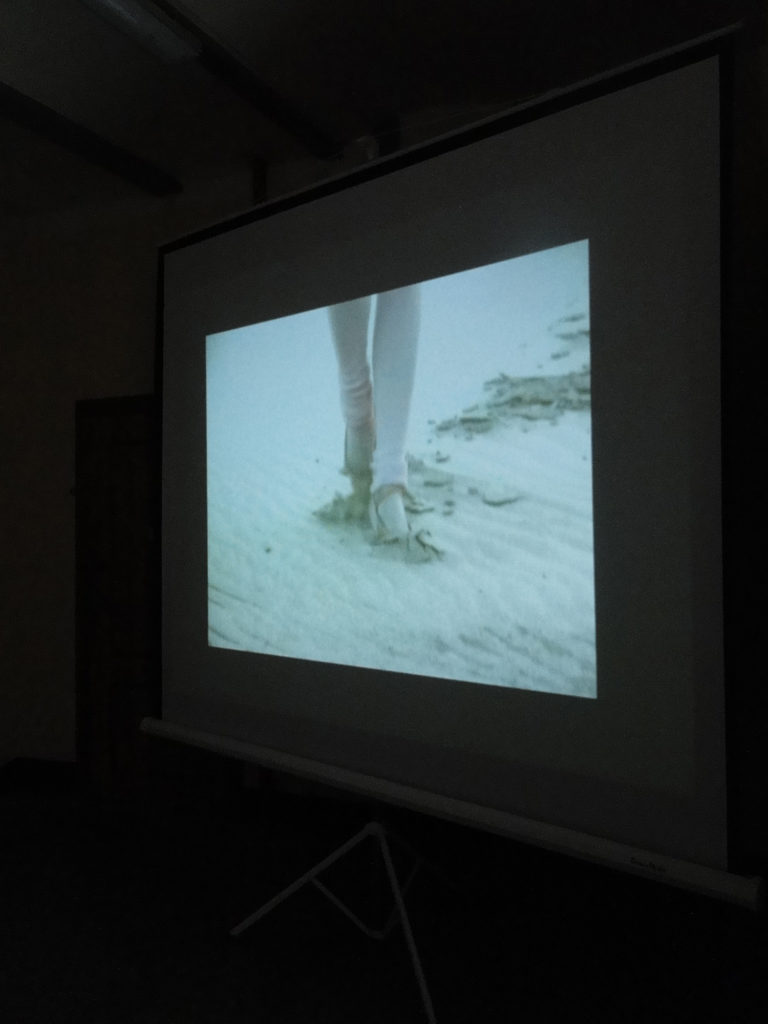
Documentatiefilmpje Mels
Documentatiefilmpje Mariëlle
As SPAR artists we were involved in two items during Museum Night. We had an beamer presentation featuring work by both of us, accompanied by our son Quirijn Dees’ music. When selecting the works for the show, we kept Ecology, the Museum Night’s central theme, in our minds. We also showed our film Water (2004), made in collaboration with the late ballet dancer Lén Staals.
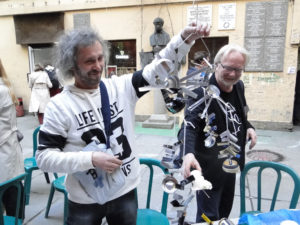
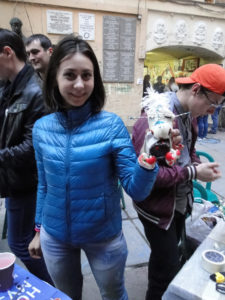
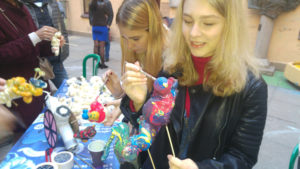
Our other activity was to conduct a workshop using waste materials – cardboard, plastic, cans and more – to recycle them into art works. Mariëlle made a mobile from beer cans and a wire clothes hanger as an example and to inspire people. It started off a nice collection of tin mobiles.
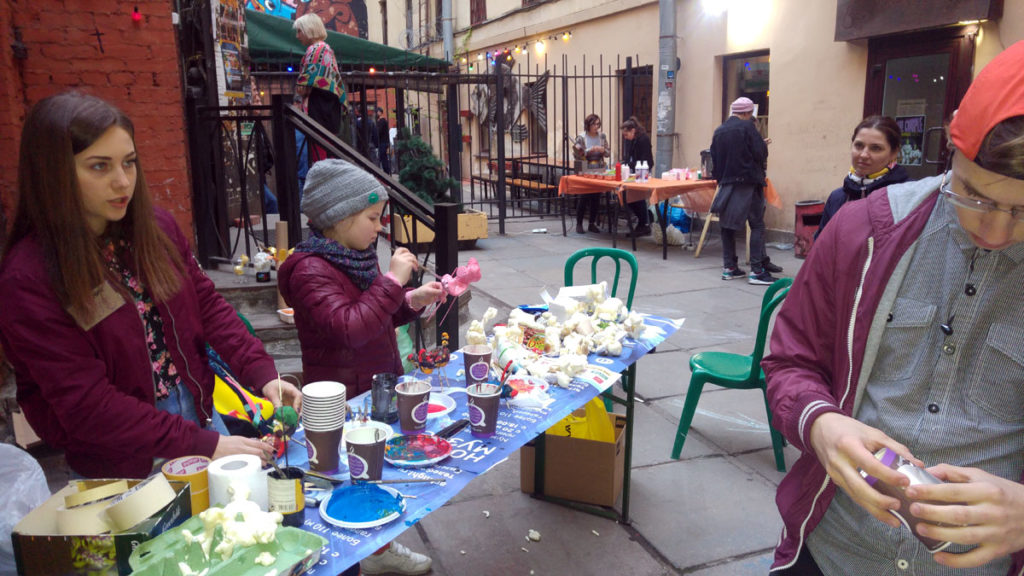
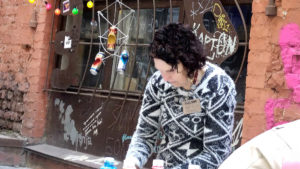
The hit of the night were the ‘monsters’ made from small waste objects Mels had injected with Styrofoam. If people got inspired and their fantasy was triggered by the weird shapes, they created the craziest beings on stick legs or sprouting from beer cans. In a couple of hours three big bags of foam objects were processed. Some of the resulting works were taken home – but many were lined up in a parade on the podium wall.
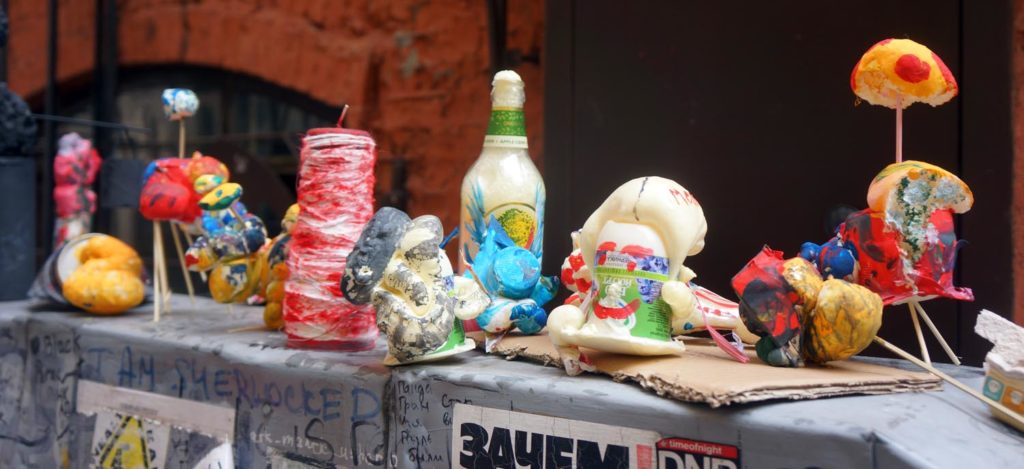
Samizdat History
Mels Dees 18-05-2017
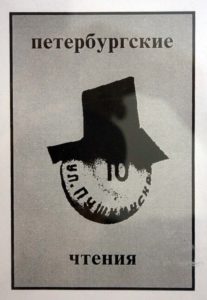
Soon after arriving at SPAR, we started to realise we were living in a monument of sorts, or at least a tourist attraction. The complicated entrance (we have to go through a porch off Ligovsky Prospect, then a door, past the doorkeeper, down a stairs, out by another door, cross a small courtyard full of graffiti, pass a second porch to yet another courtyard, open a door with a primitive electronic lock, go up two flights of worn-down marble stairs – the lift isn’t very reliable – and open our apartment door with an aged brass key), this complicated entrance then, is often full of admiring Russian people taking photographs and selfies against the background of aging posters and improvised artworks.
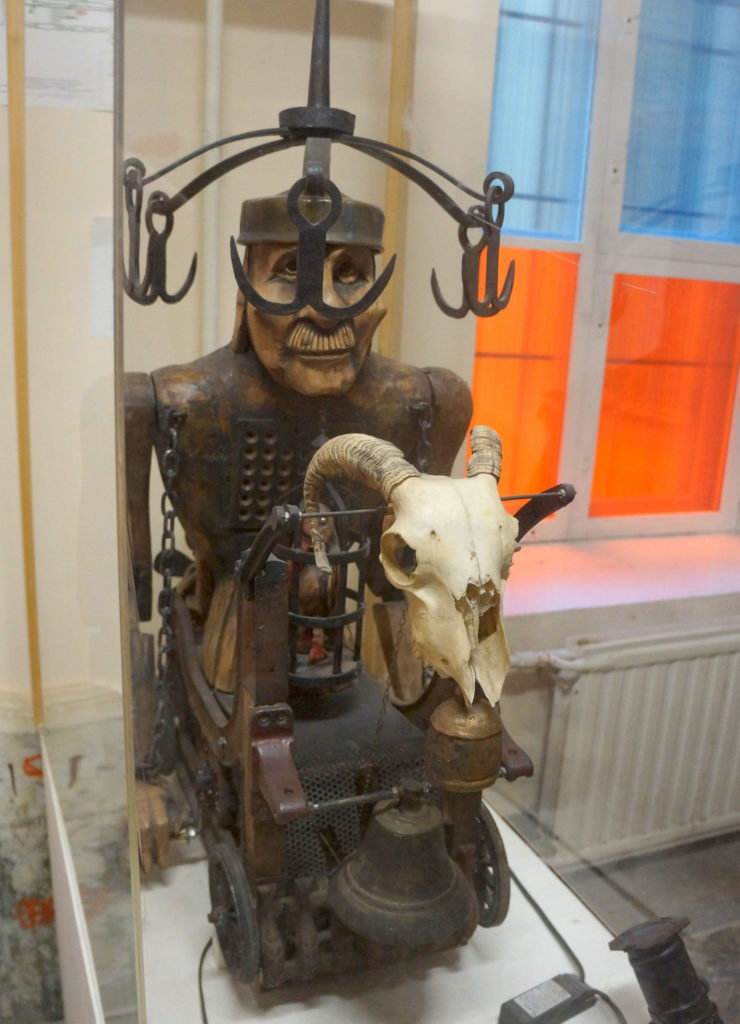
The artwork at our front door. At unpredictable times it comes alive and clangs about a bit
The visitors range from very young and hip to old and pretty haggard and sometimes seem to be on a kind of pilgrimage to this place, which has been a stronghold of Soviet and Russian subculture since the ’70s. In one of the corridors there is a permanent exhibition about the political Samizdat during the ’80s, while there are several other, sometimes rather obscure exhibitions spread through the buildings, such as The Museum of Sound and The Rock Museum.
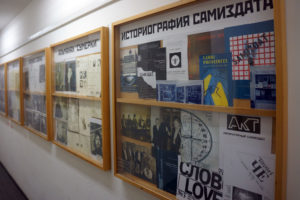
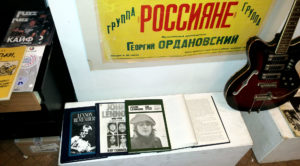
The Rock museum – consisting of only two small rooms – captures the spirit of freedom and resistance rock music used to spread during Soviet times and beyond. Obviously, it is inspired by the ’60s western pop culture but it has both a more existential and a rather home-grown look. Hardly surprising, as records and magazines were not available and song texts had to be copied in writing or with typewriters. Even electric guitars were almost impossible to get, and the museum shows some examples of beautiful home-made models.
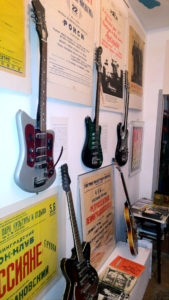
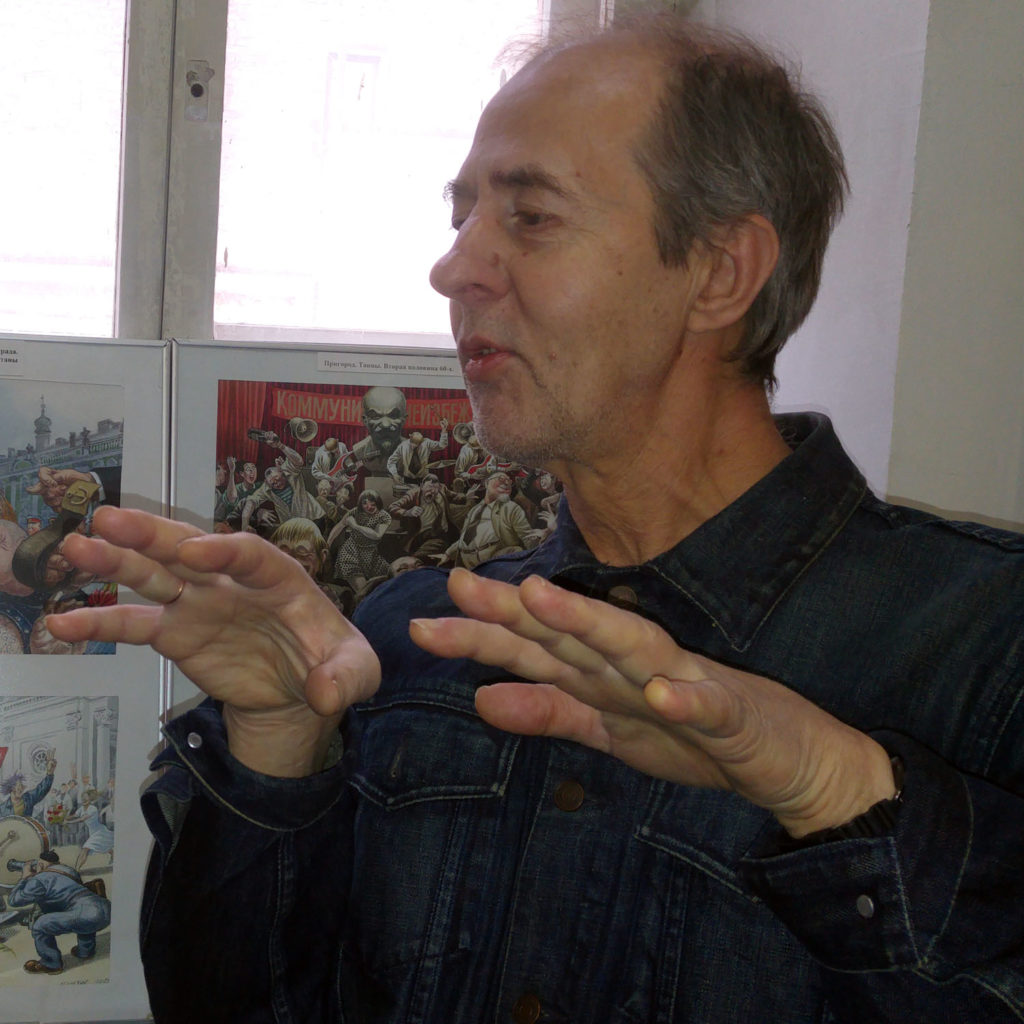
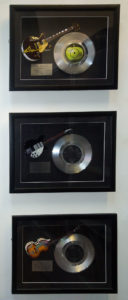
The initiator of the rock (POK) museum is Vladimir Rekchan. He is an enthusiastic collector and one of the few old Leningrad Rockers still living to tell their stories of the seventies and before. Many of his friends have succumbed to age, drugs and rock and roll. Or to wodka, like Rekchan’s artist friend Sergej Lemechov. His underground drawings are toxic jewels, incredibly detailed depictions of the private and public hell he lived in. In the west he is virtually unknown – his work deserves more than that.
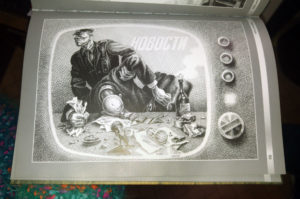
Victory Day
Mariëlle van den Bergh – 15-05-2017
We were lucky to witness the 9th of May celebration of the victory that ended the Second World War in 1945. In Russia you sometimes get the impression this victory was entirely accomplished by the Russians alone. Anyway, it is an event that evokes the ‘great’ Soviet area, so you see the hammer and sickle and the red flags reappearing everywhere. The main street in Saint Petersburg, the Nevsky Prospect, is decorated with stylish banners, flanking golden stars, all in a rather cardboard fashion and hanging high above the streets. On the sidewalks the commercial advertising pillars now show pictures of some of the fallen heroes. They are printed on huge posters, with their full names and other details on display. They were all different – it was impossible to find doubles. So each poster seemed to be a unique print, made only for this occasion. There must have been thousands of St. Petersburg’s fallen sons on the streets on the 9th.
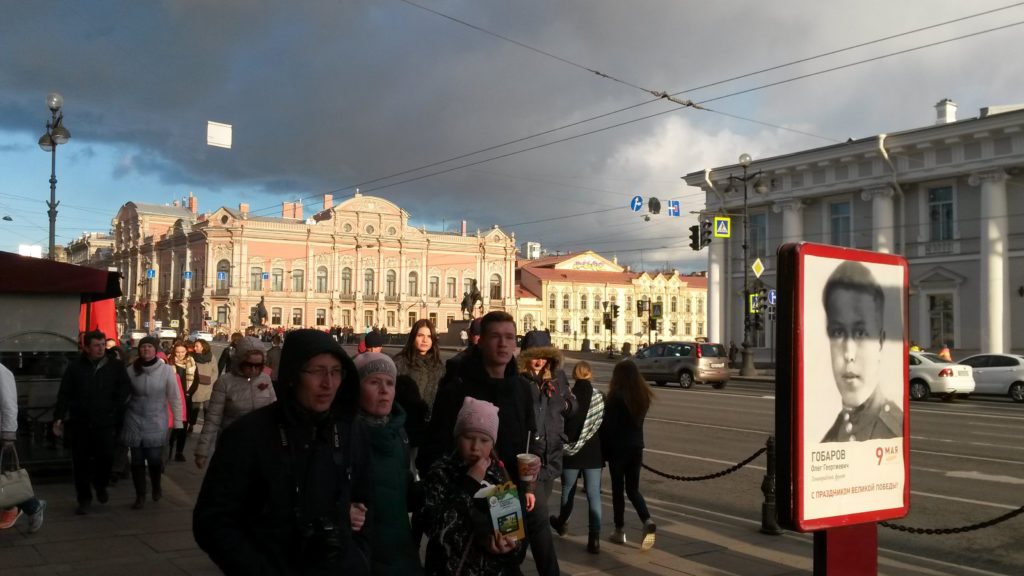
The day started with parades everywhere but the main one was in Moscow. Here in St. Petersburg we had been able to witness the construction of the stand for the parade on the big square in front of the Hermitage, when we queued to get in the museum a few days before. The parade started simultaneously all over the vast country at 10.00 A.M. Moscow time. We were able to see it on a live television broadcast. Russian president Putin was of course overseeing the whole ceremony, which lasted for hours. Later we saw a compilation of the festivities in other regions. What they all had in common were the vast electronic displays in the middle of squares, showing the Moscow celebrations in real time.
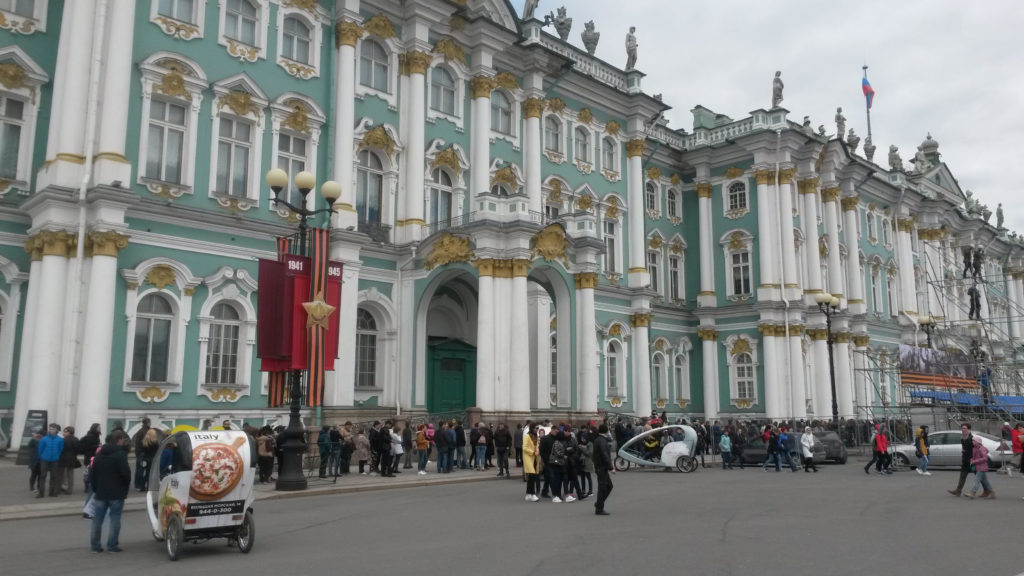
Anastasia, the director of our residency programme SPAR, filled us in on some background information about the March of the Immortal Regiment. In the afternoon of the 9th of May, family members march through the streets, holding placards with pictures of beloved family members that died in WWII. Usually they also wear a bow of a orange-black ribbon on their breast. Sometimes they wave red or Russian flags. Mels and I went to see the fireworks at night. Coming and going over the Nevsky prospect, we submerged in the lively and cheerful crowd. There were families and bunches of youngsters afoot as were couples of all ages. Every hundred meters you would encounter a new treat like a living statue, a vendor of balloons, pigeons, a dressed-up bear, a beautiful girl in Louis XIV style, and so on. You make a selfie with them for some small change. And of course musicians would play. The merry fans would wave banners or MacDonald flags and sing along the popular Russian hits. We listened to two aged musicians, one playing the accordion and the other singing in a well-trained opera voice. Someone would toss them a banknote and ask for a special tune and then the whole small group sang some alltime favourite with dedication and ardent patriotism. Look at the video below!
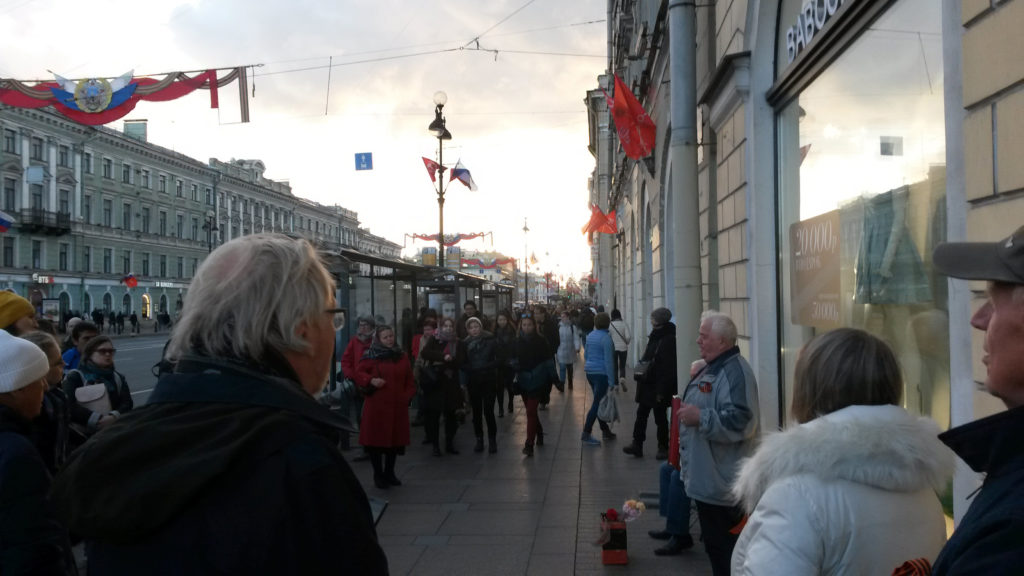
At 22.00 the fireworks started. The great booming sounds of cannons were heard everywhere and quite a crowd had gathered near a canal, from where you had an unobstructed view over the bridges and boats. The intriguing en quite complicated firework show lasted only 15 minutes, but was served in a continuous programme of beautiful pictures. The crowd cheered each time to show its appreciation. When it was over, no time was wasted and the St. Petersburg mob hurried home at full trot, or to a restaurant or railway station.
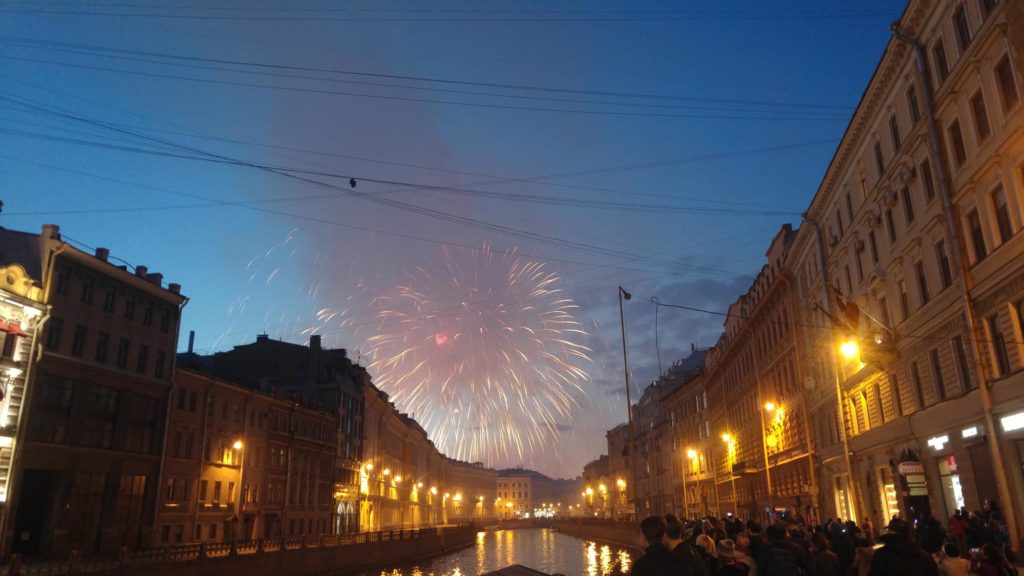
CROSSING BORDERS
Mels Dees, St. Petersburg 03-05-2017
Instead of slowly travelling by boat and car for many days and thousands of kilometers – as we did on our way to the Reykjavik residency – it took us just a few hours to get to St Petersburg. I know, it has become commonplace to virtually everybody, but I find air travel increasingly humdrum and shallow. Both your origin and your destination are depersonalised, dissolved in a heavy mist of commercial imitation luxury. And during the first days at your destination everything remains slightly unreal. The soul travels by horse, indeed.
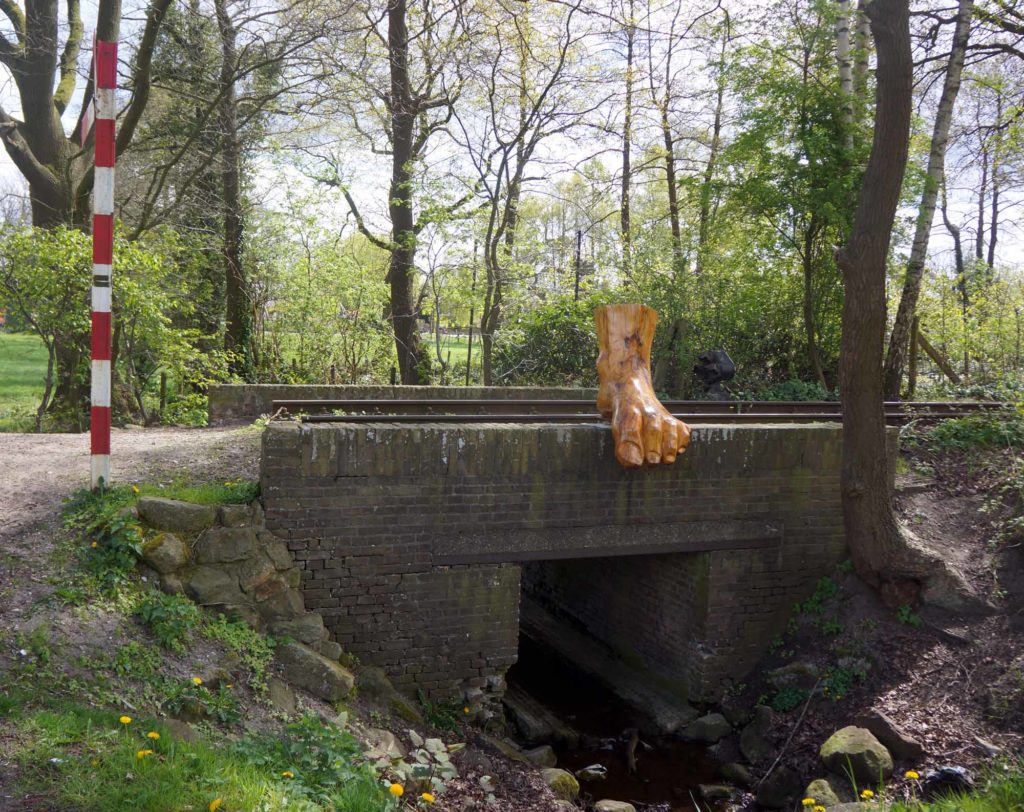
But when I look at the pictures I took over the past few days, the contrast becomes clear. Compare the idyllic picture of the wooden Foot I installed for the manifestation KunstenLandschap at Enschede, the Netherlands, with the violent (although humorous) art at entrance of our St. Petersburg residency.
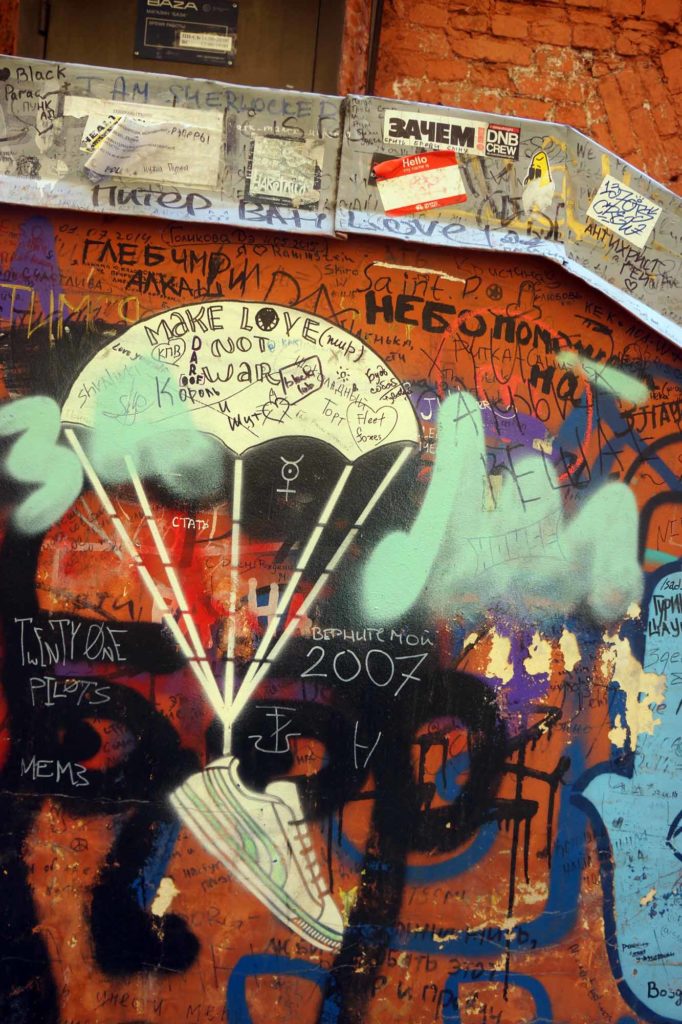
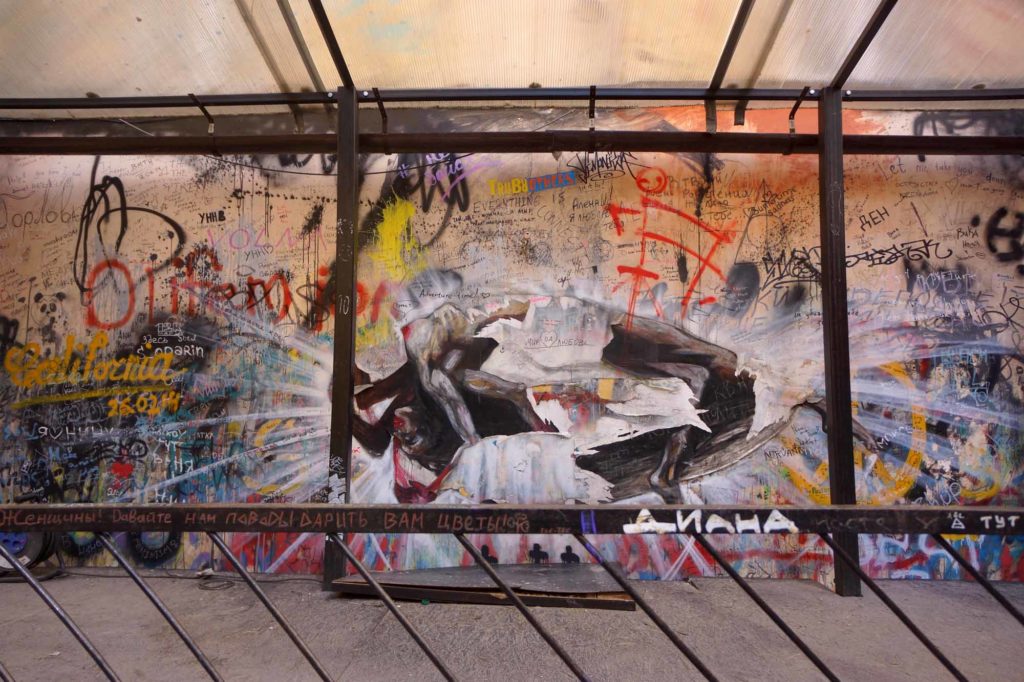
The good thing was that, on the very first day, we lost our way in the outskirts of Piter. Nothing like getting lost in an unknown city to convince yourself of the reality surrounding you. However, behind the former Iron Curtain, few things are what they appear to be. The past tends to bend everything out of perspective and provides wry interpretations of even the simplest things.
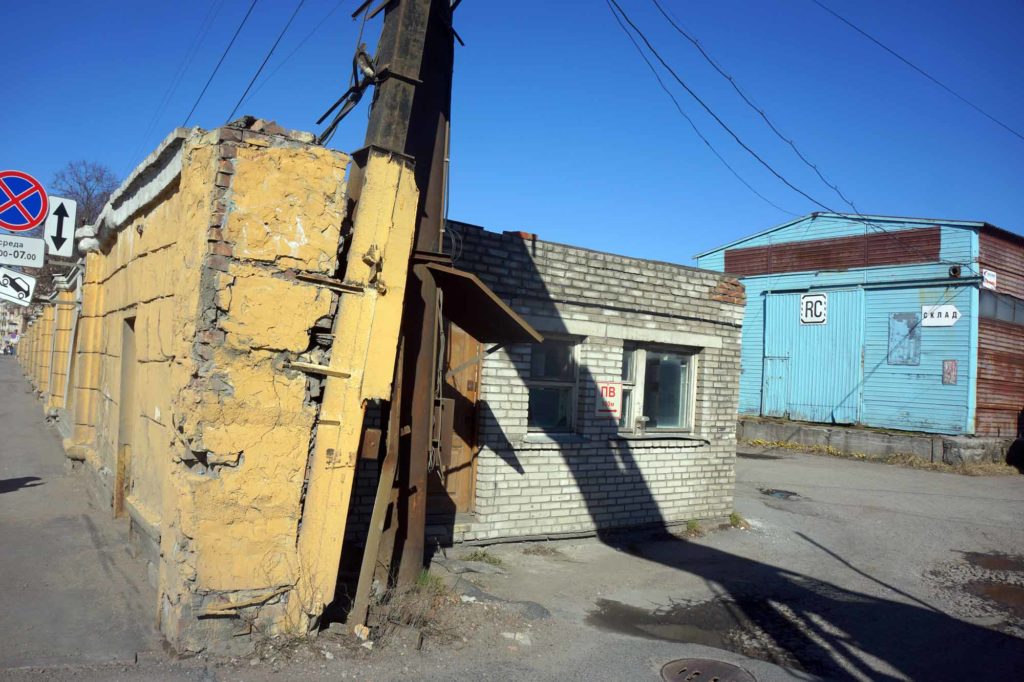
Walking along Lygovsky Prospekt, just outside St. Petersburg centre, we passed a seemingly endless, yellow-painted wall. It looked like a 19th-century park wall, with the trees and the manor inside burnt down in revolutionary times and replaced by ugly industrial sheds.
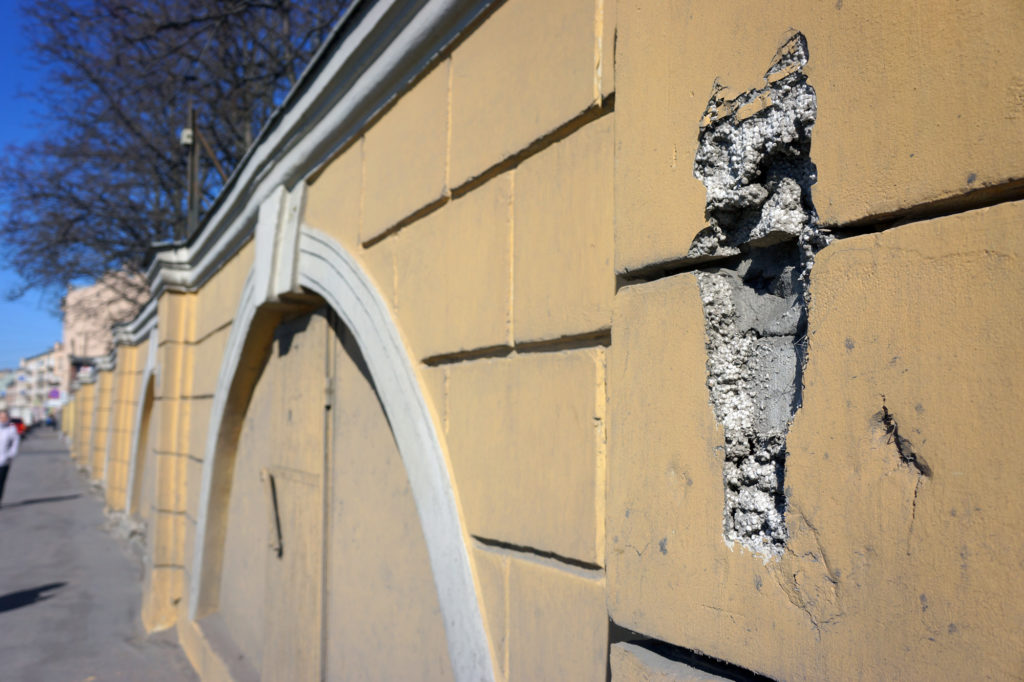
However, on investigating the structure, it turned out that the wall had been extensively repaired – or even built from scratch – using Expanded Polystyrene (EPS), which must have become available in the Soviet Union only by the 70s or later.
So what happened on Lygovsky Prospekt? Was it an attempt to hide the ugly buildings from tourists behind a fake facade, comparable to the Potemkin Village built for Catharina the great? What about the other buildings in town? How real are they?
CONTRASTS
Mariëlle van den Bergh, St. Petersburg 04-05-2017
There couldn’t be a larger contrast between being an artists in residence in Iceland and being one in Russia. Yet, with only a three-weeks touchdown in Holland, Mels and I switched from one to the other. We took the airplane at Schiphol, Amsterdam and arrived on the first of May in Saint Petersburg.
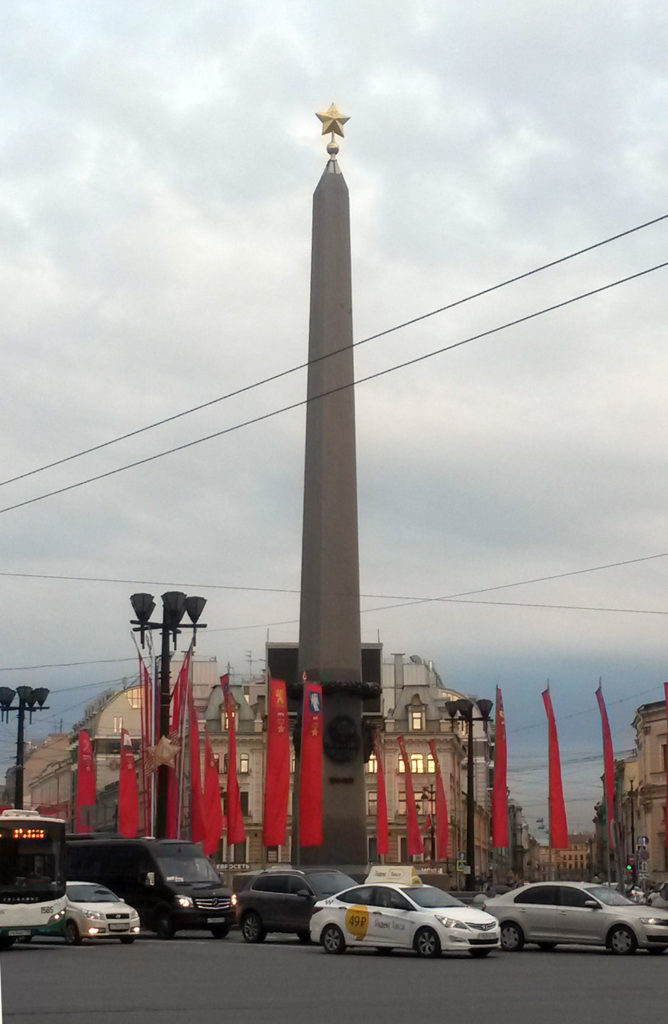
Let’s compare. Iceland is Europe and Russia isn’t. To stay in Iceland there was nothing to arrange, just go there. To stay in Russia, you have to apply for a visa, and be officially invited by a Russian art organisation. In our case that was SPAR, Saint Petersburg Art Residency. www.artresidency.ru
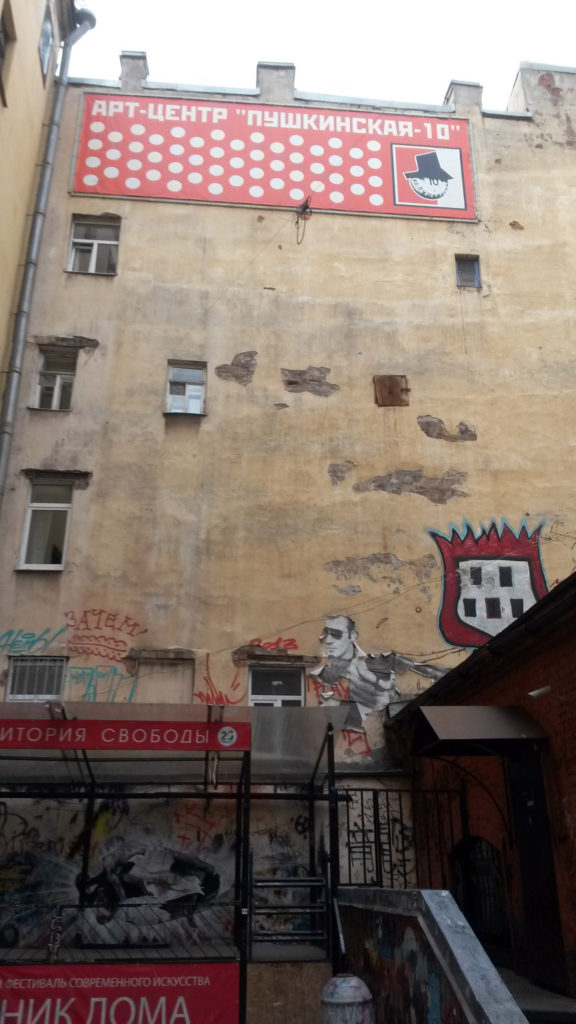
Also, although Saint Petersburg is only two hours and 20 minutes by airplane from Amsterdam and much nearer than many destinations in Europe, it is not considered to be European. You need to check your health insurance polis for instance, if you are covered for this part of the world. Saint Petersburg is the second largest city of Russia and competes with Moscow for being the nicest, most urban, sophisticated, wealthiest, etc. city of Russia. It hosts a couple of million citizens while Reykjavik, the capital of Iceland, has little more than 100.000, one third of the country’s entire population. So Saint Petersburg is a big city. While in Iceland, we stayed at Korpulfsstadir, ten kilometers outside the centre of Reykjavik. In Saint Petersburg, we are right in the heart of the metropolis. As an illustration I include the views from both our apartments.
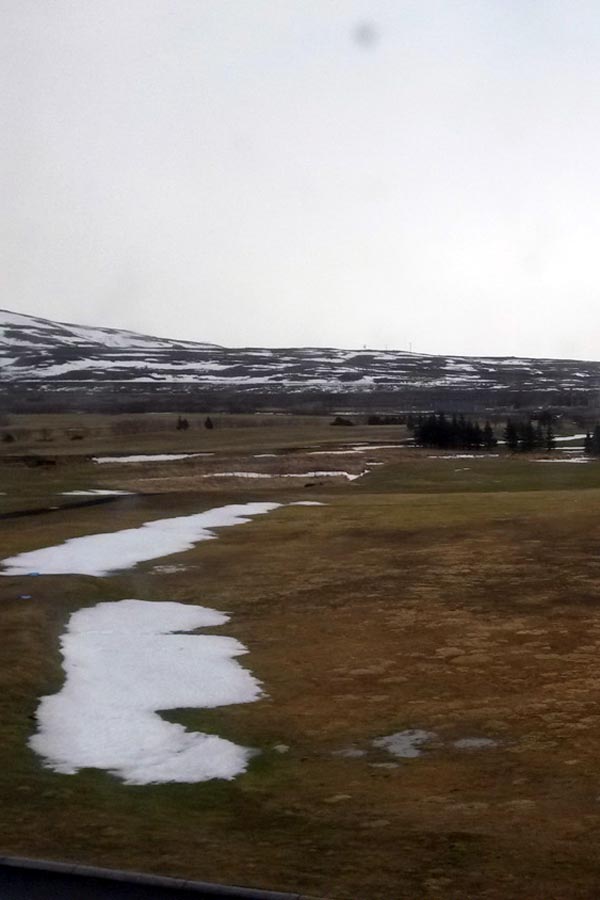

Both countries have their own currency, but there’s a huge difference in what you can buy for it. For instance: the price of a beer. In Iceland it is hard to find one in the first place. In special liquor stores, the Vinbudin, a nice home-brew beer would set you back some € 8. Which is the same price at Happy Hour for a pint in the local Reykjavik pub. Mind you – during Happy Hour you only pay half the usual price of the drinks. In Russia every supermarket has a broad range of alcoholic and non-alcoholic drinks. Especially the Vodkas are omnipresent, but one can also choose from a real good variety of local and international beers and wines. A Russian pint can of beer is to be purchased for €1. We haven’t been in pubs yet, but you get the idea. There is a lot of food available in Russia and it has its own specialities, like a broad range of mayonnaise (with mushrooms, with herbs, with meat, with this or that fish), ditto pickled vegetables, and local pastries.
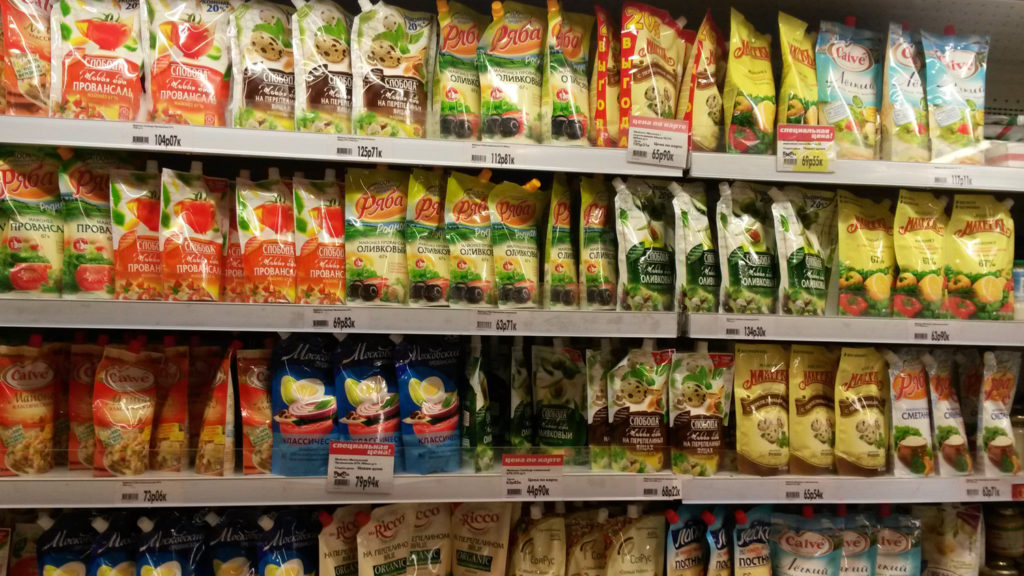
The other difference that catches the eye is the population on the streets of both capitals. While the general population of Iceland descends from Vikings and the rest of the people in Reykjavik consists of tourists, mainly Asian, in Saint Petersburg you will mostly just see Russian citizens.
But what a tremendous country it is! Its population ranges from Caucasian to Mongolian to Persian types. Although almost everybody speaks Russian and is Russian, it provides a very international atmosphere. Crossing the Russian border and continuing to travel through the same country, you could cross Europe several times over before you reach the end of Russia. I like this feeling a lot even if, in the tiny country that Holland is, you can also meet many nationalities. And sometimes visitors from abroad are already freaked out by the fact that we are with over 17 million people.
